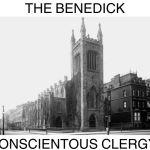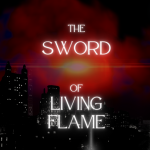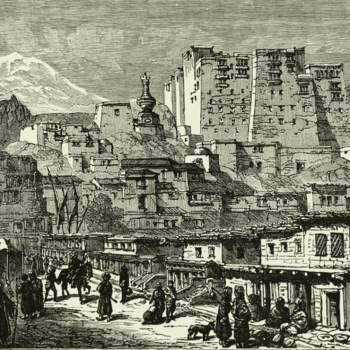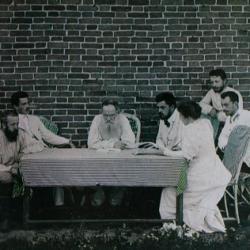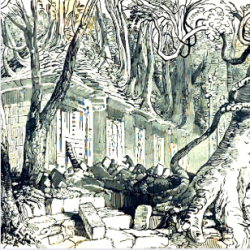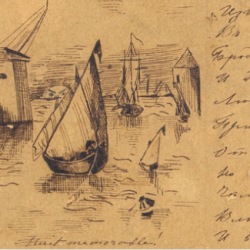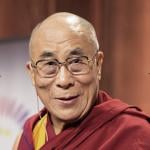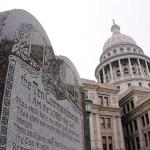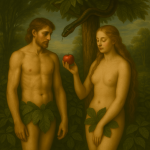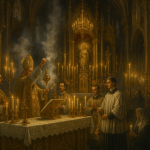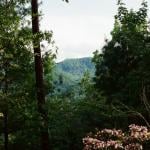THE SHADE OF SATTAY.
⸻
This is the story of Govindarao Sattay, the first male Brahmin to visit America in 1884. He would experience both generosity and malice in that country, including imprisonment for declaring his beliefs. Sattay would ultimately die in New York, and be the first South Asian of any caste to be cremated in America. Paving the way for the likes of men like Swami Vivekananda, I think his name, and legacy, merits remembrance. I hope this account contributes to that endeavor. This is not a biography of single person, however, rather the biography of an idea. Sattay’s story does not end after his death, as the reader will discover. [A longer serialized version of this story titled “Out-Castes” can be read here.]
⸻
PART I.
~
Govindarao Sattay was born in Sholapore, India, around the year 1845. He was a Chitpavan Brahmin, who adhered to a strict vegetarian diet, and wore the sacred threads, the zānave, across both shoulders and chest. His spiritual life played an important role in his life, and he prayed a simple prayer twice a day: “O Thou who givest life to the universe, fill us with thy life. Thou hast created all, to Thee we must return.” Of his early life, little was known, “except that he was married, had one son, and lost his wife while the child was still young.” He was educated at the College of Madras, spoke seven languages, possessed “remarkable conversational powers,” and was familiar “with the best English authors.” He began his career as an accountant in Madras, and by 1883 he was working in the Calcutta Post Office in the employ of the British Civil Service. “The English give no opportunity to the masses of the people’s to learn more than the rudiments of letters,” Sattay would state. “To educated Hindus, only clerical positions were ever assigned in the Civil Service.”
His critique of the British extended to the Christian missionaries in India, where, in Calcutta alone, fifty sermons a month were delivered by Methodist preachers to “heathen” audiences. Sattay’s compatriots initially presented the missionaries “basketsful of all kinds of vegetable dainties,” but when they discovered “bones and feathers of innocent birds and beasts,” on the property around the missionaries’ houses, the gifts ceased. The “religionists from foreign shores found many converts when they first arrived,” Sattay would state, but the Indian people found “that beneath the glitter there [was] much lead.” Though Sattay “accepted the teachings of Jesus as an evolution of the teachings of the Shastas,” he “refused to make a separate profession of truths which he believed to be included in his native faith,” and would debate the missionaries in open-air discussions “largely attended by the natives.” Provocation was not necessarily his goal, but Sattay, like the other natives of India, had few options to ventilate their grievances. “The censorship of the press restricted the freedom of patriotic expression,” Sattay would say, “[the] present hope of the emancipation of the country was nothing.” Surendranath Banerjee, the editor of The Bengalee, for example, was imprisoned in May, 1883, by the British for daring to publish comments in his paper that were critical of the judiciary system of the British Raj.
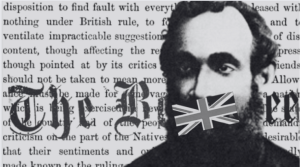
Surendranath Banerjee.
The social scaffolding of India, which served the people since antiquity was in disrepair according to Sattay. In his estimation, this was due to a failure on the part of the Brahmins who abused their sacerdotal authority for personal gains. “Our warrior classes have been exterminated twenty-one times by the Great Parashurama, and our Bhattacharyas extinguished the warmth of patriotism of the other classes.” For Sattay the best hope for the people of India “was in the education of the Hindus in Western arts.”
Sattay denied that there was increased material prosperity of India under British rule, and believed that “famine in India was unknown before the advent of the English.” British democracy was also a myth “The rule there was of the sword, and by the sword,” but “not an arm, not a knife nor a stick,” was permitted to any Indian unless in the service of the crown. “An Englishman could kill an Indian and exculpate himself by his own statement before the courts,” Sattay said. “The Eurasians […] though numbering only about 40,000 or 50,000 in a population of 250,000.000, are politically more powerful than the natives, as had been proven by the Ilbert Bill controversy.” The Ilbert Bill would prove a catalyst that changed the trajectory of Sattay’s life. Introduced in 1883, the Ilbert Bill proposed an amendment to the code of criminal procedure and allow Indian magistrates jurisdiction over Europeans in India. On August 23, 1883, many Europeans assembled in the Calcutta Town Hall to consider what measures to take to ensure the bill would not be passed. Sattay, who was present at the meeting, described experience in a letter published in the Times of India:
I attended the Great Town Hall Meeting […] I took my seat between two pillars, and I shortly after found that the gentlemen sitting around me could not bear the sight of a native among them. Two of them actually tried their best to induce me to leave the seat I occupied. I boldly bore all the silly remarks they made, and when the speeches commenced, and they found that I did not join the audience in their cheers and applause, and also in their groans and hisses, with all sorts of expressions which resounded through the hall, two of them gentlemen sitting to my right and left kept pricking me with pins to force me to join their demonstrations, and when I could no longer bear the sufferings, I joined them, though much against my will, so that I might no longer be teased by them. Yet they were not satisfied, and one of them, having remarked that my clappings were not loud enough to be heard, snatched my umbrella from my hands, and stamped it forcibly on the floor. At the close of the meeting, I made my way to the platform and tried to speak a few words to the effect that the attitude taken up by them was against the principles of Christianity. But no sooner had I opened my lips than they all rose and resounded the hall with their hootings and hissings. I was immediately surrounded by several of them, and one of them pulled me down the platform. I was almost suffocated and crushed, but I soon made my escape through the crowds. Is this treatment in keeping with the doctrines of Christianity?
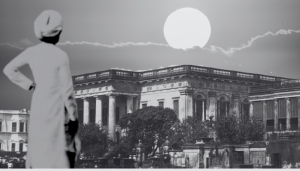
Calcutta Town Hall.
~
Two days later, while Sattay was still recovering, an account of the meeting was published in the Friend Of India and Statesman: “Every section of the European community was represented largely, and the speakers were at times unable to control the deafening applause with which any special expression of opinion was greeted.” Just above that column there appeared another article titled, “A Brahmin Lady Medical Student In America.” It was a reprint of a letter from an American missionary friend of the eighteen-year-old Chitpavan Brahmin woman, Anandibai Joshee, who recently left India to study medicine in the United States in April, 1883.
Ocean Grove, New Jersey,
June 19, 1883.
I sit down to tell you of a visit my sister and I made last week to Mrs. Joshee. She has probably written you that her friends met her promptly on the arrival of the steamer, and took her at once to their home in [Roselle.] The lady with whom she is stopping is very agreeable and cultivated. […] They have two very dear little girls, about seven and nine, so Mrs. Joshee’s opportunities for improving in English are very good […] She has learned a good deal since she left the shelter of her own home, and she has conducted herself with great modesty and propriety. She seemed very happy to see me, and took me with great pride to show me her own room, and how neatly her friend had arranged it for her comfort. I smiled when I remembered that she had told me at sea that she hoped she would be allowed to cook for herself in her own room, for she prepared her own Indian food. If she were not well-balanced, her head might be turned with numerous newspaper notices. We are a news-loving people, and the novelty of the arrival of a Brahmin lady to study medicine has attracted a good deal of attention; but she receives it all very quietly.
Sattay was naturally curious about Anandibai, and after his experience at the Town Hall he began to think “very seriously, of organizing a movement for the emigration of his people, that they might ‘escape from British rule.’” He decided he would follow in the footsteps of Anandibai, and “see for himself what [America] offered.” This was a major decision, for as Sattay writes: “A Hindoo can not cross the ocean and go to Europe or America without losing his caste.” Anandibai was the first Brahmin woman to travel to America, and few, if any, Brahmin men had dared make the trip.
~
Sattay sought out Anandibai’s husband, Gopalrao Vinayak Joshee, a Brahmin postmaster who lived in the city of Serampore. Gopalrao, a graduate of Wilson College in the Bombay Presidency, held unconventional views, especially with regard to women and education, and at forty-one, was nearly twice the age of his wife. The Joshees tried, unsuccessfully, for several years to find an institution in India where she could study medicine. A letter regarding this pursuit, which was published in The Missionary Review, caught the attention of Theodocia Carpenter of Roselle, New Jersey, who offered to sponsor Anandibai in America. In October, 1883, Anandibai would begin her studies at the Woman’s Medical College of Pennsylvania. When explaining his motivation for encouraging Anandibai’s education, Gopalrao stated:
I [thought] for a long time that medicine was one of the best studies to be taken up by those who wish to do good. When a boy I read the story of Howard, the philanthropist. I thought I’d like to do as he did: I went to a hospital in Poona to see what I could do for the suffering and wash their wounds, but I found I could not bear the sight. I believed early that woman can elevate man if she be well educated. My first wife was studying when she died. I then tried to get a young girl I could educate. I married my present wife when a mere girl. I sat by her day and night and taught her till she was able to come to America and prosecute her studies.
Gopalrao was as critical of the British as Sattay. “I hate the English from the bottom of my heart for their cruel oppression of my country and my people,” he said. “It does not show itself [among the Indian people,] because it dare not be shown, but it is there, gathering strength and rancor with every new wrong.” His views on English missionaries were likewise unfavorable. “They don’t lean sufficiently on the native element,” said Gopalrao, but added: “The Catholic missionary, on the other hand, stands by his people.” This provisional addendum for Catholic missionaries was likely informed by Pandita Ramabai, a cousin of Anandibai, who converted to Catholicism in England, in September 1883, and was widely discussed at the time.

Gopalrao Vinayak Joshee c. 1894.
~
One of the few people who openly supported Ramabai was Jyotirao Phule, the leader of the campaign against “Brahminocracy,” who re-purposed the Marathi term dalit to describe the “untouchables” born outside of caste. Gopalrao supported Phule’s cause, as evidenced by his friendship with Protap Chunder Mazumdar, a Shudra member of the Brahmo Samaj who was, at the time, in America promoting his book, The Oriental Christ (1883.) Anandibai, writing to Gopalrao at this time, said: “I feel proud to mention that the Bengali gentleman Babu Protap Chunder Mazumdar has received much acclaim here.” Phule and his wife, Savitribai Phule, both pioneers of women’s education in India, likewise supported Anandibai and Gopalrao.
~
The liberality of their thought led both the Joshees and Phule into membership in the Theosophical Society. Gopalrao joined in 1879, while Anandibai joined on March 11, 1883, just weeks before leaving for America. Phule joined the society a year earlier in Poona, in August, 1882. Founded in New York City in 1874 by Col. Henry Steel Olcott, Helen Blavatsky, and William Q. Judge, the Theosophical Society was a transnational spiritual movement that made its headquarters in India in 1879. The society championed religious pluralism, emphasized the importance of Eastern traditions, and freely explored the noetic potentialities in the human experience. With ideas counter to those of normative Christianity, the missionaries in India viewed the organization with suspicion. Of the reason which Gopalrao joined, it was said:
[Gopalrao] saw Madame Blavatsky several times in 1879 in the Bombay Presidency. Of course he “took no stock” in the Theosophist theory about “adepts,” and all the rest of it, but he considered that the effect of discussion by Europeans of Oriental formulas with reverence and respect in the presence of the natives was to give the latter a better opinion of themselves.
Anandibai’s interest in the movement was not passive. Writing to her sister in late 1880, she states:
I think you have heard of Madame Blavatsky and Colonel Olcott. They are making wonders in India. The papers are full [of] the account of the occult phenomena of Blavatsky. She is [a] staunch advocate of Vedic philosophy and asserts that all the new things discovered or invented were formerly in practice in India.
Phule was likely introduced to the Theosophical Society through his friend, Tukaram Tatya, a successful merchant in Bombay of the Bhandari caste. When working for the Walcot Company in his youth, Tukaram met Phule and other lower-caste reformers of Poona, who opened his eyes to the inequality of social division. Tukaram would write Jalibheil Viveksar (1861,) the first book written in Marathi which critiqued Hinduism’s religious hierarchy from the perspective of a lower-caste adherent. Phule, who published Jalibheil Viveksar, praised the work for its critique of the Brahminic monopoly of learning and authority. Tukaram joined the Theosophical Society in 1880, two years before Phule, and would become the de facto leader of the Bombay Branch when the Theosophical Headquarters relocated to Adyar, India. With the desire to elevate native scholarship, Tukaram would establish the Theosophical Publishing Fund in Bombay, and publish works with English translations, and in Indian vernaculars, pertaining to philosophy, metaphysics, the Vedas, and the Upanishads.

(Left) Mahadev Govind Ranade (Center) Tukaram Tatya (Right) Jyotirao Phule.
~
The author Caroline Healey Dall states that Sattay left Calcutta in April, 1884, on a ship named The Valiant, but “the vessel sprang a leak, and the captain put into Mauritius to unload.” Dall states that due to the necessary repairs of the Valiant, Sattay was detained in Mauritius for nearly four months, during which time he worked as an accountant. “It is probable that Anandabai had written to him enthusiastically about her new home,” Dall writes, “for she always said that her first year in America was the happiest year of her life.” Dall was probably mistaken with regards to the name of the ship on which Sattay embarked. H.M.S. Valiant, in the service of the British Navy, was not a mercantile ship, nor was it stationed anywhere near Calcutta at this time. The Valiant would be involved in an accident in Bantry Bay, Ireland, in July, 1884, but the details of that accident do not match the details which Dall provides. The only shipping incident at this time which resembles Dall’s narrative, is one which involves the Norwegian barque, Iphigenia, bound for the Cape from Calcutta in early May, 1884. The Iphigenia was damaged at sea, and began to leak at a rate of two inches per hour. Her crew was forced to jettison five tons of cargo and dock at Diamond Island near Rodrigues, Mauritius. If we accept the key points of Dall’s account to be true, then it is more likely that Sattay left Calcutta on board the Iphigenia. While detained at Mauritius, Sattay investigated the living conditions of the coolie laborers, a topic of which was widely discussed at the time.
~
After discussing the matter with Sattay, Gopalrao decided that he, too, would travel to America. “The English missionaries […] make attacks on my religion and customs,” said Gopalrao, “I want to find out what is fact and what is falsehood.” This decision would have been made soon after meeting Sattay, for Gopalrao states that during a conversation with the President of the Theosophical Society, Col. Olcott, he made his intentions known that he planned on traveling to America “as a mendicant.” This meeting would have occurred before February, 1884, at which time Olcott left India for an extended sojourn in Europe. Gopalrao states that he left India without any plans for food or lodging and only $2.50 in his pocket, just enough to pay for his passage to Rangoon, which he reached on June 22, 1884.
~
Around the time that Sattay and Gopalrao began their trek to America, news of a conspiracy reached Olcott, who was then in Paris with co-founders, Blavatsky and Judge. Emma Coulomb, a disgruntled former member of the society was planning to discredit the Theosophical Society by disseminating insider information to the missionaries of the Free Church of Scotland, and other hostile actors. The Scottish mission, then in the headlines for allegations of sexual impropriety at their school in Calcutta, were only too happy to deflect the vitriol toward an easy target. Judge was dispatched to India to investigate the matter. Judge left England on June 18, 1884, on the S.S. Clan MacGregor, and arrived in Bombay on July 15, 1884, where he was debriefed on the situation by Tukaram. Five days later, en route to Madras, Judge lectured in Poona, where he met the social reformer, Mahadev Govind Ranade, and very likely encountered Phule. “Even the coolies in the street have larger brains than the same kind of man in the West,” said Judge at this time. “It is the duty of the Hindus to furnish to the West, and to the world, the truth in philosophy, the truth in morality, and the truth is science.”
A thirty-two year old lawyer from New York, Judge had little love for the English. Growing up in the “Docklands,” a “very poor locality” on the fringes of Dublin, he knew the hardships endured under British rule. His life changed in 1860 when his mother, Alice, died in childbirth in their family home at 36 Seville Place. “I have seen ghosts ever since I was a boy,” Judge would later say, “my mother, being dead, appeared at my bedside and looked down on me.” At thirteen, Judge and his surviving siblings immigrated to America with their father, Frederick, arriving in New York on July 11, 1864. Taking root in Brooklyn, Frederick raised the children “under the spiked yoke of hard Methodism.” Judge became an active member of the church, and was praised for involvement in the Young Men’s Christian Union at the Fleet Street Methodist Episcopal Church. It was through the church that Judge met Ella Miller Smith, a Brooklyn grammar-school teacher, and graduate of The Packer Collegiate Institute (For The Education Of Females In The City Of Brooklyn,) whom he would marry in September, 1874.

(Left) George Pierce Andrews. (Middle) E. Delafield Smith. (Right.) Henry Steel Olcott.
In the early 1870s, Judge began work as a clerk near City Hall in Manhattan, where he studied law under Assistant Attorney George Pierce Andrews, and District Attorney, Edward Delafield Smith. It was through this connection that Judge first met Olcott, as both Andrews and Smith worked with Olcott during the trial of Soloman Kohnstamm.
Outside of his network in the church, Judge ran with a circle of friends that included colleagues from City Hall, and reporters from nearby “Printing House Square,” such as David A. Curtis, Edward Page Mitchell, and Frank Church. Judge would attend poker nights with the journalists, where he earned the nickname “The Adept,” because of his “undoubted skill at the game.” Mitchell, editor and correspondent for The Sun (New York,) described Judge as being “a smooth spoken-person with contemplative eyes in which lurked both professional sagacity and somewhat of Oriental craftiness.”
In the summer of 1875, Judge and Ella became the parents of a baby girl, whom they named Alice, presumably after Judge’s late mother. The young family lived with Ella’s widowed father, a shoe-dealer named Joseph Smith, at 160 Gold Street in the Vinegar Hill neighborhood of Brooklyn, known colloquially as “Irish Town.” At this time, Olcott was writing extensively about his investigations of occult phenomena with Helena Blavatsky, whom he met a year earlier at a séance conducted by the brothers, Horatio and William Eddy, at their homestead in Vermont. Upon their meeting, Blavatsky allegedly summoned the spirit of Bessie, Olcott’s daughter, who died just before her second birthday. Bessie, Olcott states, reached out her hand to caress his face, and one would imagine, provide closure to her father. “At my request,” Olcott states, “[her hand] came back for me to kiss it.” On August 30, 1875, Olcott wrote a letter to the editor of The New York Tribune in defense of his investigations, stating:
If the priceless treasures of the Alexandrian Library had not been used to heat the public baths, the “Lost Arts” of the the ancients, including the art of communing with the dead and the power to look beyond the veil to our future home, might not be now “lost” to all but a select few in the Oriental fraternities.
Judge contacted Olcott requesting an introduction to Blavatsky, who was then living at Irving Place in Manhattan. Having received an invitation from Blavatsky, Judge called upon Blavatsky with a young colleague, and future Attorney General for the Kingdom of Hawaii, William Richards Castle. Impressed with her powers, Judge and Castle returned a week later, marking the beginning of what would be The Theosophical Society. “Why need we only meet and talk,” asked Blavatsky, “why not materialize; why not, at the present moment, form a society and undertake the study of truth in connection with this great and absorbing subject?”
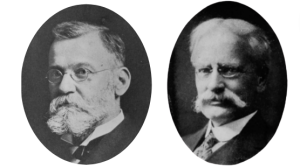
(Left.) William R. Castle. (Right) David A. Curtis.
Three years later, the summer before Olcott and Blavatsky would move the headquarters of the Theosophical Society to India, Judge and his family were staying in Asbury Park, New Jersey. It was a community in sympathy with, and adjacent to, the Methodist camp-meeting resort of Ocean Grove, led by Rev. Ellwood H. Stokes. Despite their claims to health and rejuvenation, Ocean Grove and Asbury Park operated under notoriously unsanitary conditions, of which the health officials of the communities were well aware. Rev. Stokes admitted in 1878 that “vast numbers” of people abandoned “every sanitary rule and regulation observed at home,” when attending the meetings. Even with this knowledge, on August 29th, 1878, during a service attended by six thousand people, Rev. Stokes personally baptized a number of children. Two days later Judge noticed that Alice was running a high fever. Four days later, on September 2, 1878, Alice died from diphtheria. Her death had a profound, and life-long, effect on Judge.
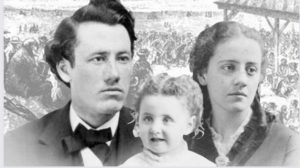
(Left) William Q. Judge (Center) Alice Judge. (Right) Ella Judge.
When Olcott and Blavatsky departed America in December, 1878, Judge was left directionless and alone in New York. Writing to Olcott in April, 1879, Judge confessed: “Often there is much sorrow and longing in my heart after the little one [has] gone away.” With Alice gone, Judge’s purpose in life was channeled into cultivating the remnants of the Theosophical Society in America until such a time when it would produce a sustainable spiritual harvest, even turning down a promising job offer from Castle, who returned to Hawaii shortly after meeting Blavatsky. “In [Judge’s] letters to me,” Castle writes, “he expressed his contempt for the trammels of Christianity and hoped I had become freed of its servile bondage.” Judge’s disappointment with “Churchianity,” which he differentiated from Christianity, the true teachings of Christ, are found in his many letters to Olcott at this time. Judge writes: “The very first step necessary [in America] is to show the people how wrong is their estimate of the East, and what lies they have been told by the missionaries.” The “damn preachers make me furious,” he added.
~
Judge moved to 116 Willoughby Street in 1881. After the departure of Blavatsky and Olcott for India, Judge, for many years, “was the only Theosophist in New York [and] about the only man in the metropolis who knew a philosophy of that name existed.” Judge was determined to hold meetings, even if he was the only one present. By January 1883, Judge befriended his neighbor; a journalist and fellow named Laura C. Holloway. She hosted Sunday evening discussions in her home at 181 Schermerhorn Street, Brooklyn, with like-minded students of mysticism. “The visitor would almost surely be met by people of distinction in literary or social circles; prominent among them was Edward Dwight Walker, writer and editor for Harper’s Magazine.” Holloway reflects of this time:
In speaking of his personal life to his friends, [Judge] had several times told them incidents connected with his little daughter, an only child, whose sudden and unanticipated death had, as he expressed it, “about broken his heart.” And, later, when writing about the grief it was costing him to cast anchor and set sail for India, he referred again to the loss of his child, and mentioned this sorrow as one of the sources of his present strength.
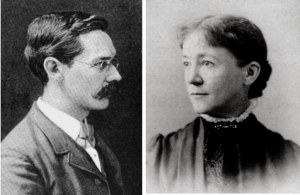
Edward Dwight Walker. Laura C. Holloway.
~
Judge focused his energy into revitalizing the malnourished Theosophical Society in America, and by the close of 1883 his work was beginning to yield results. At the time the new word “Aryan,” and the concept of “Aryan Christianity,” was filling the columns of the New York papers. On October 28, 1883, The Brooklyn Daily Eagle printed a lengthy excerpt of Mazumdar’s Eastern Christological conception:
Keshub [Chunder Sen] (the Brahmo leader) speaks of Christ as the prince of idealists. And his religion is spoken of as supreme idealism. And it is in this idealism that India has a hold on the real nature of Christ and Christianity. The East has always been the home of idealism. The prophets and seers of Asia penetrated the veil of phenomena, and saw behind it the life and meaning of all things. Exuberant nature, making slender calls upon physical energy, invited the mind to communion and contemplation. Zoroaster on the mountain tops, the old Aryan sages of India in the deep wood or romantic river banks, found the whole world idealized before them into the purposes and perfections of the Great Spirit.

Protap Chunder Mazumdar.
This was printed concurrently with the serialized translation of Marc-Aurèle et la Fin du Monde Antique, the latest work of the French philologist and historian of religion, Ernest Renan, which appeared in The Sun. One chapter stated:
Among the debased nations of the East, Christianity is a religion of very moderate merit, inspiring very little virtue […] Christianity has been truly fecund…In the beginning a wholly Jewish product, Christianity has come in this way, in the process of time, to shed almost every trace of its ethnic origin, so that the contention of those who proclaim it the Aryan religion par excellence is, from many points of view, well-founded […] The Bible has in this way borne fruits not its own; Judaism was only the wild slip on which the Aryan race has grafted its flower.
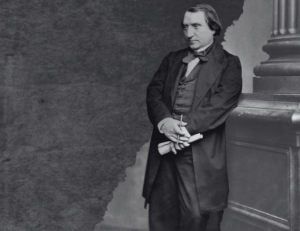
Ernest Renan.
Inspired by this new vision of a mystical restorationist Christianity, Judge decided that his new Branch would be called “The Aryan Theosophical Society of New York.” The epithet Aryan indicating that the Society was separated from the mainline Christian world.
~
On October 6, 1884, after conducting his investigation in Adyar, and before returning to New York, Judge attended the inaugural meeting of the Samuskrita Basha Abhi Virtini, the new Sanskrit school at Madras Christian College. Ragunath Row, a fellow Theosophist and former Deputy Collector of Madras, occupied the chair. He was a “man of power,” who possessed a warm and cordial sense of humor, and whose bright blue eyes were something of a rarity among his people. In 1885, Ragunath Row would be among the founding members of the Indian National Congress, as well as its sister movement, the Indian National Social Conference, whose goal it was to persuade Indians to adopt a modern, progressive stance in their moral behavior. The paper read that evening, “The importance of Sanskrit literature,” expressed the sentiment of Phule’s anti-Brahminocracy by declaring that “the Brahmin priesthood brought India down to its present low level,” and that, “a study of Sanskrit would raise India among the civilized nations of the world.”
~
On November 15, Judge returned home to New York on the S.S. Wisconsin, by way of London, and arrived on November 26, 1884. The Theosophist A.E. Smythe, who first met Judge on the Wisconsin during this trip recalls:
There were eleven of us on the Guion liner Wisconsin in 1884, when I first met him on his way back from India. He was reticent about India and his business there and no one on the boat knew him as a Theosophist, but he talked mysticism and mystical subjects with me, and I presume with others. A daughter of the theologian, Dr. Geikie, with her husband, a rich New Yorker, an American dentist who had been practicing in Paris, two Pennsylvania Dutch girls who had been touring Europe, and a few other etceteras, and Judge formed the cabin group. He walked the decks with those who needed a companion, he played cards, except on Sunday when he drew the line, he played deck quoits, and he chatted, but always with a certain aloofness, and he retired for long periods to his cabin. It was November and cold and he wore a Tam O’Shanter as several others did and an overcoat and muffler. He looked old and pallid and had I been told his age was 33 I would have said it was 20 years out. We knew nothing of āveśa in those days, and still less of the battle that had gone on at Adyar for the reputation of H.P.B. These things must have weighed heavily on the mind of Judge. Yet he was cheerful and thoughtful of others, and as we neared the end of our ten-day voyage he drew up a memorial, decorated with his attractive penmanship and we all signed it as a tribute to the Captain for his courtesy, kindness and care.
PART II.
~
Judge arrived in New York on November 26, 1884, and “quietly took up his duties, and as patiently performed them as though he had never been away from them.” The Aryan Theosophical Society held its fortnightly meeting above a beer saloon at 35 Union Square, in a hall which they rented from a fraternity of Odd Fellows. General Abner Doubleday, an early member of the original New York Branch, was respectfully elected President, while Judge was named the Secretary of the Branch.
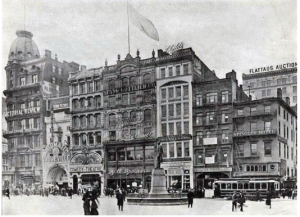
Union Square South c. 1880.
~
Curiously, Sattay, too, arrived in New York in November, 1884, about the same time as Judge. He soon made his way to Roselle, New Jersey, to visit Anandibai and Theodocia Carpenter, bearing gifts of saris and keepsakes from home. The occasion marked the first opportunity in a year for Anandibai to speak Marathi. Having devoted much of her time to her studies of medicine and English, she had lost command of her native tongue, which troubled Sattay. Anandabai states:
He thought I had lost all my nationalism and become useless, and so he gave up all hope for me! He declared me totally unfit to return to my country or even show my face there.
The unpleasantries of Sattay’s rebuke must have been resolved, for Sattay’s estimation of Anandibai is overwhelmingly positive in subsequent transactions, and he appears to have endeared himself to Theodicia Carpenter, with whom he retained correspondence.
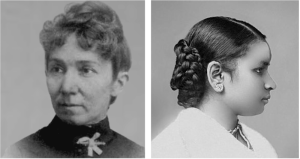
(Left.) Theodicia Carpenter. (Right) Anandibai Joshee.
Sattay then took some time to consider his next moves. His initial idea was to pass the winter with the coolies of British Guiana, who lived in daub cottages on the periphery of their master’s plantation. This idea was abandoned when Sattay learned of the World’s Industrial and Cotton Centennial Exposition, which was to be held in New Orleans, Louisiana from December 16, 1884 until June 2, 1885. Believing that there “would be so much to learn there that [would] be useful to his people,” Sattay postponed his visit to British Guiana, left a sum of money with the Carpenters, and left for New Orleans.
~
While Sattay was visiting Anandibai, Gopalrao was having an unpleasant experience in Siam. “I have not met a human being worse than the Siamese,” Gopalrao states. He soon made his way to Hong Kong, and during an address titled, “India Past, Present, Future,” delivered on November 24, 1884, at Temperance Hall, Gopalrao said of British India:
Where there was unity, there is now disunion; where there was harmony, there is now discord, where there was sobriety and temperance, there is now drunkenness, whose votaries can be counted by millions. We were very honest and faithful in our dealings, and kind and loving, as brothers ought to be. We are now quite the reversal: we are now the greatest liars, deceitful fornicators, and forgers.
In early January, Gopalrao left Hong Kong for Yokohama, Japan, on the steamer S.S. City of Rio de Janeiro. On board the ship, he befriended William Willes, a Mormon missionary to India. Through Willes, Gopalrao learned of the hardships which the Mormons were then facing. In 1882 the U.S. Federal Government passed the Edmunds Act, which outlawed polygamy. The pressure was so great, that by 1885, John Taylor, President of the LDS Church, was forced into hiding. Willes and Gopalrao parted ways in Japan, but they agreed to correspond when Gopalrao arrived in America.
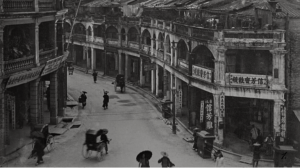
Hong Kong c. 1880.
~
With only $10 in his pocket, Sattay arrived in New Orleans in January 1885. He soon found employment at Stern’s Fertilizer and Chemical Manufacturing Company in the Third District of the city.
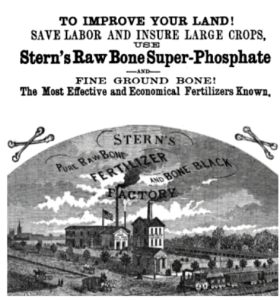
Stern’s Factory.
The setting was less than picturesque, but Sattay quickly acquired a knowledge of Western industrial art. Acclimating to the quotidien life in America took longer. “He ate rice, potatoes, oatmeal, corn and sometimes eggs. Frequent were his conflicts with restaurant keepers who sought to insist on his feeding on abhorrent meat.” This discomfort was not a deterrent, as Sattay was willing to advocate anything for his compatriots, “even a meat diet,” if it meant their ultimate “political and religious emancipation.”
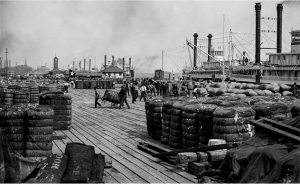
New Orleans Docks, 1880s.
~
After lecturing in Japan for a few weeks, Gopalrao arrived in San Francisco, California, possibly on board the City of New York which arrived on March 8, 1885. Anandibai sent word to Gopalrao that Dr. Rachel Bodley, the Dean of the Woman’s Medical College, whom she boarded with, found a job for him teaching Sanskrit. Anandibai did not approve of this, however, suggesting, instead, an alternative:
All colleges already have their own teachers and do not seem to need more. In this situation we must find an alternative ourselves. The one which has occurred to me is to earn money by giving lectures. I can see that this sounds like a clumsy suggestion, but it is the best by far. I am not too proud or greedy, but I too have ambition.
He was soon giving lectures, and attending séances, which fascinated him. Through his connection with Willes, Gopalrao met the Mormons of San Francisco, including Anna Kimball, a daughter of Heber Kimball, one of the original twelve apostles in the early LDS Church.
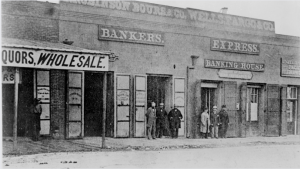
Wells Fargo & Co. Express building, Stockton, California
While in San Francisco, Gopalrao would visit T.Y. Read, “one of the most scholarly and best read men in the town,” and the Wells Fargo’s agent in Stockton. Here Gopalrao would retrieve his regular letters from Anandibai. One letter from Anandibai was in response to an inquiry as to the whereabouts of Sattay. Anandibai writes:
I think I have written to you whatever I know about Govindrao. There is no letter from him since he left Roselle, and that is not my fault.
In a follow up letter on March 30, Anandibai writes:
I need not beg your pardon for the flutter I was in, and I have not uttered a word anywhere about Govindrao, but I cannot help saying that I am severely disappointed at his indecision and lack of purpose. His own words reveal his fickleness. Perhaps I am unduly inquisitive, or have misunderstood matters, but even so, I do not think that I am distorting the truth. He himself has never divulged his plans to me.
~
Sometime in April, 1885, Sattay wrote his own letter to Gopalrao, in which he states that he found much inspiration from Patrick Ford’s newspaper, The Irish World. “Despite the difference in the people, the conditions of Ireland and of India are much the same,” Sattay would say. He proposed to Gopalrao that they publish their own newspaper in America, The Indian World, so they might “expose the frauds of the British rule in India,” and “inculcate patriotism in the hearts of the home patriots.” In the remainder of the letter, Sattay writes:
Sometimes I repent that I was too hasty in leaving our dear land; at another time I feel satisfied that we will be able to secure at least the honor of becoming the first Hindoo-American settlers, paving the way for future crowds of immigrants from British India seeking shelter in this land of freedom.
New Orleans, I find, is the fittest place for our people to begin with. Here our complexion passes for some Southern European nation. In India we are called and’ looked upon as “n—” by the white men, while here the emancipated negroes, as well as the white men, both look upon us as either Spaniards or Mexicans. My friend, had I learned the art of folding our turban I would never have taken the cap in Bengal, and if I should put on a hat here in summer it would be simply to “keep up to the time, place and people,” which, you know, is my motto. My dear friend, strange dress is no doubt an attraction; but change of dress, or even the change of food, does not change our convictions.
Since I left India my faith in the primitive Hindu religion of the Vedic times has become stronger. I have been able to see the mischief done by the subsequent rules and regulations of the Bhāṣyakāra. Had it not been for these religionists, our country would not have come to her present degraded condition. She has been so much split that there is no uniting possible. It is useless to say that 250,000,000 souls form one nation. The Malayalees of Calicut, and the Oorians of Jaganauth are quite different types of people. A combination of fifty-six such sections is almost an impossibility. If there be any bright future for our country, it is at a very great distance.
We want a large number of workingmen to come down and earn their bread at different factories and thus learn the different arts in this country. We want graduates to emigrate. Can this be possible? I wish to see 300 patriot Indians leaving their country, sworn, like the followers of Leonidas, to accomplish their aim.
After this letter was sent, both Sattay and Gopalrao increased their lecturing, granted interviews, and contributed articles to local papers, all for the purpose of providing Americans with Indian perspectives of India. On March 30, hostilities between the Russians and British escalated in Afghanistan, and their opinions on the matter were of great interest to readers. “If the Russians should gain a decisive victory early in the trouble,” said Gopalrao, “there is no doubt in my mind that the Indian regiments would at once join them.” On May 17, Sattay visited the offices of The Times-Democrat (New Orleans,) where he offered his perspective. When asked if Indians preferred British or Russian rule, Sattay replied: “England, without a doubt. It we have, and find its rule tolerable, though offensive. Of Russian rule we know nothing, and naturally bear the ills we have rather than fly into those we know not of. But we should, of course, much prefer to govern ourselves.” He then elaborated on the injustices of British rule:
Mr. Sattay emphatically denies the increased material prosperity of India under British rule, and urged that famine in India was unknown before the advent of the English. Of the democratic character of English institutions, he said nothing was seen in India. The rule there was of the sword, and by the sword. Not an arm, not a knife or a stick, is allowed to any Indian unless in the service of England. The censorship of the press restricted the freedom of patriotic expression and present hope of the emancipation of the country was nothing.
Sattay would soon become the “Bengal Correspondent,” for The Times-Democrat, where his occasional columns offered an Indian’s insight into matters of politics and religion. His critique of British rule continued in his article, “From A Hindoo,” in which he states:
Readers, you can form no idea how the British Government has been working the ruin of the land internally as well as externally. English politicians and Christian missionaries give you bright stories of the brightest possession of England, but to India and her people the English are the darkest rulers she has ever had. Since the advent of those all-absorbing grocers, the great organization of our nationality has been so much disturbed that the caste system, which was the very strength of the Hindus before, has now become the weak side, under present chaos brought on by British rule. […] Now that the world has advanced in the means of rapid communication of the news of one country to the other, it is very necessary that the great nation of nations should be in communication with the several oppressed and struggling nations of the globe. The great aim of the Almighty in creating this ever increasing republic is to elevate and liberate the subject nations of the European monarchs. I therefore wish that the daily movements of the struggling natives of India should be laid before the citizens of the United States, and that the active and noble example of this nation should serve as a lesson to them for their guidance. With such a view, I propose that there should be an exchange of the leading native journals of India conducted in the English language with the leading journals of this country. The Hindoo, of Madras, The Bengalee, and The Indian Mirror, of Calcutta, and The Maratha, of Poona, would be very much obliged to you for your kind acceptance, and at no distant future you will have the credit of sowing the seeds of the emancipation of 250,000,000 of souls, of that almost scourged and devastated country. The whole country, from the East Pacific to the West Atlantic coast know the grievances of the Hindoos, and thus give them a chance of studying the proper way and means of regaining their independence.

New Orleans.
~
Gopalrao arrived in Salt Lake City, Utah, in the middle of June, where he stayed as the guest of William Willes, the Mormon missionary whom he met en route to Japan, and with whom he maintained a steady correspondence since his arrival. He probably made his intention known to Anandibai, who wrote to him at this time: “Be very careful about giving your opinion on any subject, because those who are not Christian or Mormon are likely to cause trouble. Salt Lake City is on your way, so do visit it.” On June 19, 1885, Willes accompanied Gopalrao to the home of Helen Kimball (one of the widows of Mormon prophet, Joseph Smith,) bearing a letter of introduction from her cousin, Anna Kimball. The following day Helen gave Gopalrao a book on plural marriage, in which she wrote an inscription: “That you may be guided by the Candle of God, while journeying ‘over the hills of time.’”
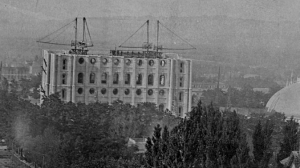
The Salt Lake Temple under construction, 1885.
On the evening of June 23, Gopalrao asked Willes to baptize him in the Mormon church. After consulting Bishop John Sharp, Willes agreed. The Mormon Mission in India closed on June 10, 1885, to baptize a Brahmin would have been a morale boost for the beleaguered Mormons. Gopalrao, however, was a far from ideal convert. On the day selected for his baptism, Gopalrao attended a spiritualist séance. Willes lectured Gopalrao on some of the “peculiarities of ‘spiritualism,’” after which the two men had a falling out. On June 30, 1885, after facing criticism from Willes in the press, Gopalrao delivered a speech at the Josephite Church, with the support of Joseph Smith III. The eldest son of the Mormon prophet, Joseph Smith, Joseph Smith III was the leader of the “Josephites,” a branch of Mormonism which did not accept the practice of polygamy. Taking advantage of the absence of John Taylor (the LDS President,) Joseph Smith III ventured into Salt Lake City to pitch his brand of the faith around the time that Gopalrao arrived. Against the advice of Anandibai, Gopalrao opined freely about the Mormons from the pulpit of Josephite Church, and it was not favorable.
~
By November Gopalrao had joined Anandibai in Philadelphia, where he made the acquaintance of the poet Walt Whitman, and continued to explore the many avenues of American spiritual expression. At a service he attended by the Hicksite Quakers on Race Street, it was said that Gopalrao “made some remarks in approval of Friends principles, which he seemed to think were in harmony with those of his own faith.”

Gopalrao’s name in Walt Whitman’s address book, November 24, 1885 entry.
Days after the Quaker service, Gopalrao stayed as a guest of the Dr. Elliott Coues, in Washington, D.C. Coues was a professor of anatomy at George Washington University, who joined the Theosophical Society on June 7, 1884. A few months before Gopalrao was his guest, he was made President of the Board of Control for the American Section of the Theosophical Society. He also established the Gnostic Branch of the society in his home city, Washington, D.C., which was something of a rival to Judge’s New York Branch. During this visit, Coues and Gopalrao were interviewed by a local paper, in which Coues made some provocative claims:
If everybody knew what Mr. Joshee and I do, the social organism of the world would be thrown into chaos. The knowledge could be used for harm as well for good, and in the hands of bad men, it would be a terrible weapon.
This claim attracted the attention of the zoologist Robert Wilson Shufeldt, honorary curator at the Smithsonian Institution, who questioned the veracity of Coues’ statement. This dispute prompted Judge to issue a public reply: “Bro. Joshee I know very well. All ridiculous impressions should at once cease about him. He is a Brahman and a patriotic Hindu.”
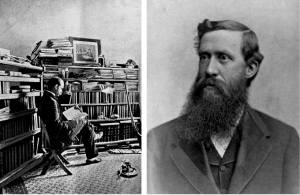
(Left.) Dr. Robert Wilson Shufeldt. (Right) Dr. Elliott Coues.
~
In New Orleans, Sattay continued writing for the local papers, where articles such as “Hindoo Kindness To Animals,” described the dietary practices of his faith. He left his job at Stern’s to begin work at Purves’ Sash Factory, a three-story frame building on Clio and Saint Charles Streets.
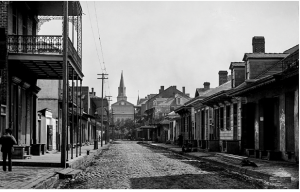
View of the Cathedral of St. Louis, New Orleans.
Writing to the Carpenters at this time, Sattay states: “I am in good health. When working in the moss factory, my lungs were affected, but since I went into the sash factory all is well.” On January 12, 1886, not long after Sattay sent this letter, a devastating series of fires broke out in New Orleans, resulting in a tremendous loss of property, especially in the Third Ward. Sattay writes to the Carpenters:
God’s arrangements are always perfect and man has only to move on till he comes to his portion. I had never dreamed that my bread and water were ready in New Orleans. If my means are small, my wants are few, also, and I am quite comfortable here. Although I met a misfortune by fire, and lost all my books, and clothing, it did not, materially, affect me. On the contrary, I am better situated, and prepared for future misfortune. Before the fire my lodgings were in an insignificant quarter and surroundings not at all to my taste. The fire misfortune has brought me closer to better society. In regard to money I have never been ambitious. I came to this place with only $10 in my pocket, and by the simplest mechanical labor, I have been able to send $40 to my country’s national fund. I have at present $60 more in the Germania Savings Bank. I do not require any money from you. If you, or your friend Mr. Joshee should need it, you are free to make use of it. My object in leaving it was not to enable you to help me, but to enable my friends and brothers to help themselves in time of need. Of course the amount is too little for much purpose, but I trust you have deposited it where it will bear fruit. Mr. Joshee writes that he intends to make some provision in America for India and her people, and if he should ask for help, I will remit my present savings from this place.

New Orleans.
~
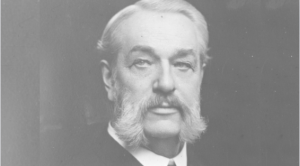
Jirah Dewey Buick.
While Sattay was settling into his new job, Judge was spending Christmas week in Walnut Hills, Cincinnati, Ohio, at the home of the Theosophist, and homeopathic doctor, Jirah Dewey Buck.
In 1885 [Buck’s] wife joined the society, and the following year, William Q. Judge, during a visit to Cincinnati, called on the doctor, and in his house Mrs. Buck’s two eldest sisters, Delia and Eloise Clough: her two daughters, Alice and Cora, and her son, Edgar, were initiated as members of the society. This made seven Theosophists in one family, and Mr. Judge dubbed them “the Theosophical family of America.” Later several other persons joined, and a branch was formed.
In recalling this time, Buck writes:
I first met William Q. Judge in the winter of 1885. He spent Christmas week at my home in company with Arthur Gebhard, who at that time was greatly interested in the T.S. work in America. Mr. Judge was at that time a devoted student of the Bhagavad Gita. It was his constant companion, and his favorite book ever after. His life and work were shaped by its precepts. That “equal-mindedness” and “skill in the performance of actions” inculcated in this “Book of Devotion,” and declared to constitute “Yoga,” or union with the Supreme Spirit, Mr. Judge possessed in greater measure than anyone I have ever known.
Arthur Gebhard, a fellow Theosophist who accompanied Judge, was involved with establishing a Theosophical magazine with Judge called The Path, which was set to debut in April, 1886.
~
Early in February, Sattay arranged for the Carpenters to send $50 from his funds to Bombay in exchange for a shipment of Sanskrit books. Sattay asked that these works to be distributed to the public libraries of New York, Boston, and Washington, D.C., in honor of Anandibai, and her accomplishment. It is probable that the works were purchased through Tukaram’s theosophical press, which recently published Tukaram’s own popular translation of The Yoga Philosophy of Patanjali (1885.)
~
On February 4, 1886, Gopalrao and Judge lectured before the Aryan Branch in New York; Gopalrao spoke on “Theosophy in India and America,” while Judge discussed Jacob Bohme. It is likely that Edward Dwight Walker was in attendance, as he would join the Aryan Branch on February 21, 1886. Walker, at this time, had left his position at Harper’s Magazine to work on a new magazine called Cosmopolitan. We might assume that he lent his expertise as an editor to Judge with The Path, which was two months away from publishing the inaugural issue. The atmosphere of the New York Branch was one of promise. For Judge, who financed the project, it was a labor of love, for neither he, nor the society, had much money at the time.
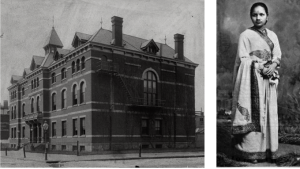
(Left.) Woman’s Medical College of Pennsylvania. (Right) Anandibai Joshee.
~
The writer, Celia Thaxter, developed an interest in Theosophy, and began a communication on the subject with Gebhard, and it is likely that her interest generated significant interest among the New England literati. It was said of Boston at the time:
Buddhism is rapidly becoming a prominent Boston “fad,” and following closely on the heels of Browningism, with a possible case of pushing it to the wall and keeping it there. The new “ism” has not taken any very firm hold, as yet, upon the masculinity of the Hub, but the gentler sex has become largely infected by it, and there is every prospect that it will soon be an all-pervading epidemic with them.
In March Gebhard went to Boston and delivered a small talk on “The Ideals of Richard Wagner, as they bear on Theosophy.” Several Bostonians were in attendance, and a “general discussion on ancient myths in the light of Theosophical ideas was held.”
The first officially recognized T.S. branch in the Boston area was chartered on December 27, 1885 in Malden, Massachusetts, a small town five miles from Boston. Its president was George Ayers, an “exceedingly nervous gentleman with bushy, red whiskers,” who joined the same month the charter was issued. Ayers was most well-known for being the first President of the Nationalist Club, an organization which was formed to “revolutionize the social fabric” after the publication of Edward Bellamy’s novel Looking Backward. A Harvard alumnus, and prominent Boston lawyer, it was said that Ayers would charge someone “for every five minutes you talk with him on legal subjects,” but on the subject of Theosophy, he would talk “by the hour and charge you nothing.”
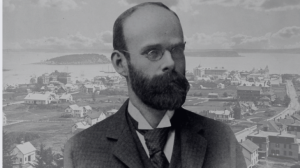
George Ayers.
~
On March 11, 1886, Anandibai graduated from the Woman’s Medical College of Pennsylvania, becoming “the first Hindu woman to receive the degree of medicine in any country.” Joining her for the event was her cousin, Pandita Ramabai. The Joshees remained in Philadelphia throughout April, where Anandibai enjoyed the well-earned celebrity which came with her accomplishments. Among the society events they attended, was Walt Whitman’s Lincoln Lecture at the Chestnut Street Opera House, where, after the address, they attended an informal reception with Whitman. Based on an account by author Ella Wheeler Wilcox, the Joshees appear to have attended a meeting of the New York Branch with Coues in Judge’s home:
The other evening I was invited to attend a meeting of members of the Theosophical Society here in New York. It took place in the parlors of a well-known New York lawyer […] a woman physician who is soon going abroad to practice in the European hospitals and several other people well known in the social or intellectual circles of New York. Dr. Coues […] addressed the assemblage with a few interesting explanations of the theosophical idea of the seven layers which compose a human being.
~
After months of planning, The Path finally debuted in April, 1886. In one of the first articles published, “A Prophecy About Theosophy,” Judge explains the prophecy of the Nadigrandhams:
The society is now, April 3, 1885, passing through a dark cycle, which began August 24, 1884; it will last nine months and sixteen days more, making seventeen months for the whole period. By the end of fourteen months next following the seventeen dark months, the society will have increased threefold in power and strength, and some who have joined it and worked for its advancement shall attain gnyanam. The society will live and survive its founders for many years, becoming a lasting power for good; it will survive the fall of governments.
The reviews of The Path were mixed. J.H. Connelly states: “When The Path first appeared, it was a mild joy to the newspapermen who knew Judge. Their occupation seems to cultivate in them a cynical materialism, not readily impressed by metaphysical abstractions…” The review of The Path in The Sun was particularly scathing.
The “intellectual circles” of Boston, we are told, find much food for thought and discussion in the literature produced by wholesale under the direction of Blavatsky and Olcott, and “the current of truth flowing through the society’s channels makes itself felt” in the inquisitive Puritan capital. […] We have received the first number of The Path, a monthly magazine “devoted to the brotherhood of humanity, theosophy in America, and the study of occult science, philosophy, and Aryan literature.” In plainer and simpler words, it is a now exponent of the clap-trap religion concocted by Mme. Blavatsky […] The Nadigrandhams, The Path tells us, are certain books which exist in India, and “resemble the Sibylline books of Rome, which prophesied, it is said, for over 200 years all the important events in the affairs of the Eternal City.”
~
Gebhard returned to Boston, and spoke on Theosophy in the parlors of Sara Bull in Cambridge, Massachusetts, with an audience comprised of Anna Lynch Botta, Celia Thaxter, Julia Campbell, and others.

Home of Sara Bull, Brattle Street, Cambridge, Massachusetts.
Of these women, Julia Cambell, who joined in May, 1886, would become a close friend of Judge. A contributor to Harper’s Magazine, and playwright of some renown, Julia won praise in 1884 for her dramatic retelling of the Salem witch trials in The Puritan Maid. This was followed by a drama called Sealed Instructions which had a very successful run at Madison Square Theatre in the spring of 1885. Her father, James Hepburn Campbell, was the former American Minister to Sweden, and her mother, Juliet Hamersley Lewis was a poet of repute. Despite her successful career, Julia’s life was marked with tragedy. A decade earlier her entire family died; first her two boys, James and Gordon in 1875, and then her husband, Phillip, in 1876. Her boys were still infants when they passed away, and Judge understood well the sadness which lingered from such a loss. In a letter dated April 29, 1886, to an unknown recipient, possibly Julia, Judge writes:
No excuse will, I am sure, be needed from me in addressing a few lines to you in your present sad bereavement, not only because you feel that I write out of sympathy, but also because we both saw the light under the same skies in the same country […] I do not deem it possible for me to enter into a mother’s feelings, but I have been a father from whom a daughter was snatched away in two days while she was in the flower of health.
~
In the second issue of The Path, issued in May, 1886, Judge responded to the criticisms of The Sun, with an article titled “Another Theosophical Prophecy.” In the article Judge “double-downed” on his position, and offered two new prophecies:
The first will seem rather bold, but is placed far enough in the future to give it some value as a test. It is this:—The Sanskrit language will one day be again the language used by man upon this earth, first in science and in metaphysics, and later on in common life. Even in the lifetime of the Sun’s witty writer, he will see the terms now preserved in that noblest of languages creeping into the literature and the press of the day, cropping up in reviews, appearing in various books and treatises, until even such men as he will begin perhaps to feel that they all along had been ignorantly talking of “thought” when they meant “cerebration,” and of “philosophy” when they meant “philology,” and that they had been airing a superficial knowledge gained from cyclopædias of the mere lower powers of intellect, when in fact they were totally ignorant of what is really elementary knowledge. So this new language cannot be English, not even the English acquired by the reporter of daily papers who ascends fortuitously to the editorial rooms—but will be one which is scientific in all that makes a language, and has been enriched by ages of study of metaphysics and the true science.
The secondary prophecy is nearer our day, and may be interesting—it is based upon cyclic changes. This is a period of such a change, and we refer to the columns of the N. Y. Sun of the time when the famous brilliant sunsets were chronicled and discussed not long ago for the same prognostication. No matter about dates; they are not to be given; but facts may be. This glorious country, free as it is, will not long be calm: Unrest is the word for this cycle. The people will rise. For what, who can tell? The statesman who can see for what the uprising will be might take measures to counteract. But all your measures can not turn back the iron will of fate. And even the City of New York will not be able to point its finger at Cincinnati and St. Louis. Let those whose ears can hear the whispers, and the noise of the gathering clouds, of the future, take notice; let them read, if they know how, the physiognomy of the United States, whereon the mighty hand of nature has traced the furrows to indicate the character of the moral storms that will pursue their course no matter what the legislation may be. But enough. Theosophists can go on unmoved, for they know that as Krishna said to Arjuna, these bodies are not the real man, and that “no one has ever been non-existent nor shall any of us ever cease to exist.”
Judge must have felt emboldened, if not vindicated in his predictions. On May 4, 1886, concurrent with the release of the second issue of The Path, a bomb planted by Socialist agitators detonated at a labor demonstration in Haymarket Square in Chicago, Illinois. A fatal riot ensued known as the Haymarket Massacre, which unnerved the American people.
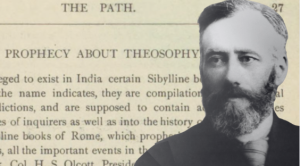
William Q. Judge.
~
On May 16, 1886, Purve’s factory went up in flames. Writing to the Carpenters on May 22, 1886, Sattay states:
Sixty men are thrown out of employment and the owner is entirely ruined […] The climate agrees with me; but the summer is a dull season at the South. Thousands are doing nothing.
PART III.
On May 29, Gopalrao shared a stage with Frederick Douglass at the annual meeting of the Free Religion Association in Boston, where he delivered a speech titled “What Is Lacking In Christianity.” Christianity, “of all shades and shapes,” according to Gopalrao, was “destitute of every noble attribute.” Gopalrao continued his condemnation on Christian missionaries in India in June with a lecture in Concord, Massachusetts. He would continue touring the Mid-Atlantic and New England with five proposed topics of discussion: “The Present Condition Of India,” “The Missionary Labor In India,” “The Religions Of India,” “The Social Manners And Customs Of The Hindus,” and “Buddhism Contrasted With Christianity.” Anandibai, who was grateful for the kindness and generosity of her Christian friends, was no doubt embarrassed by her husband’s provocative address. She was also beginning to display symptoms of an unknown illness.
~
By the middle of June, Sattay arrived in Ocean Grove, just when the first Methodist “tenters” were arriving to their summer encampment. He soon found work in construction, building the new Engine House for the E.H. Stokes Hook and Ladder Company. It was a point of pride for Ocean Grove, as the municipality had recently purchased a new steam fire engine. With the exception of his turban of black silk, he wore the simple clothing of an American laborer, and lived in a shack near the construction site, across the railroad track just outside the confines of Asbury Park. Gopalrao soon rendezvoused with Sattay in Asbury Park, and proposed that his old friend give up his employment to become the manager for his lecture series. Sattay accepted, and successfully arranged several speaking engagements for Gopalrao in the hotel parlors of Ocean Grove.
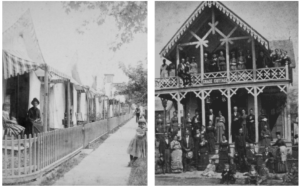
(Left.) View of tourists in front of bath houses. (Right.) Grace Cottage.
~
As the Fourth of July advanced in Ocean Grove, “cottage and tent decoration became the order, until every flagstaff bore a star-spangled banner, and every dwelling was adorned with National emblems.” While the bells of the “tenters” echoed across Wesley Lake on Independence Day, Judge was in Rochester, New York, in the home of Josephine Cables, Secretary of the American Board of Control (of the Theosophical Society.) Judge and the leading members of the American Theosophists were attending the annual meeting of the Board of Control. Cables, in addition to her position as Secretary for the Board of Control, was the President of the Rochester Branch, as well as the editor of theosophical journal, The Occult World. In the coming weeks she would preside over a meeting which changed the name of the group from the Rochester Branch to the Rochester Theosophical Brotherhood, and host the first series of public Theosophical lectures, the inaugural meeting of which, it was anticipated, Gopalrao would lecture.
One notable member of the Rochester Branch was the social theorist, Matilda Joslyn Gage. In addition to her own notable achievements, she played an influential role in the life of her son-in-law, and fellow Theosophist, L. Frank Baum, the author of The Wonderful Wizard of Oz.
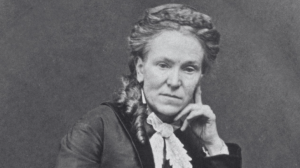
Matilda Joslyn Gage.
~
In early July, while Anandibai was in Roselle, the Carpenters began to suspect that her illness was more serious than first believed. The Carpenters advised her to go to Delaware County, New York, where it was hoped that the fresh air would alleviate her symptoms. Writing from Delaware County on July 20, Anandibai told the Carpenters: “I am having chills three times a day, and fever. My whole body is aching.” When Gopalrao learned of this, he made arrangements for Anandibai to join him in Rochester, and postponed his lecture at Cables’ home. Before leaving New Jersey, Gopalrao instructed Sattay to remain in Asbury Park, and continue the lectures himself, to which Sattay agreed. Sattay quickly attracted attention wherever he could collect a group of listeners, and shared stories of his tradition and culture.
Among other statements was made this; viz., that Hindus worshipped the images which they, in fact, make of clay for memorial decoration upon certain high festivals, throwing them into the river when the day is over. Wealthy persons have images of gold for use upon such occasions; these are preserved, for, as Mr. Sattay used to say with his rare smile, “I do not think an American would throw a gold image into the river.”
~
On August 15 Gopalrao gave a lecture to a full room at the Rochester Theosophical Society. Once again, he criticized Christianity and the industrialized world. On August 19 Gopalrao gave another lecture in the rooms of the Rochester Theosophical Society. Anandibai was showing signs of a serious illness. Hoping, again, that fresh air would help her condition, Gopalrao and Anandibai left Rochester for Niagara Falls on August 20, 1886, and were joined by the Carpenters shortly after.
~
Back in Ocean Grove, it was reported in the newspapers, that Sattay was paid a visit by an unknown man:
A stranger appeared at the Grove in mid-August asking for Sattay, and said that he met him in New Orleans, where he had been stranded by missing his steamer for New York, and had appealed to this gentleman for a five-cent postage stamp for a foreign letter he had written. The gentleman had since heard that Sattay had come North, and was anxious to renew his acquaintance with Sattay. Later the two men were seen constantly together about the streets, and it was apparent from their conduct that they were more intimate than had been indicated by the stranger’s story.
With the assistance of Ellen C. Brooks and Martha Foster Inskip, Sattay was allowed to give his lectures in the rooms of many of the cottages and hotels. Martha Inskip, the widow of Rev. John Inskip, was instrumental in raising funds for the completion of a new building for the Calcutta Girls’ High School, and Sattay may have known her from Calcutta, as she was there with her late husband and a party of missionaries in 1880.
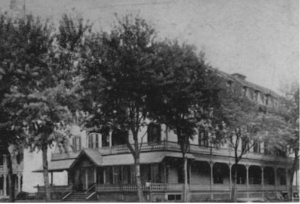
United States Hotel Main & Beach Avenues, Ocean Grove, New Jersey.
The lectures were essentially a religious forum where the differences between Hinduism and Christianity were discussed. Trouble arose when Sattay attended The 14th Anniversary of the Woman’s Foreign Missionary Society United States Hotel and addressed the ladies who filled the parlor. It was said:
[Sattay] denounced Christianity in terms of unaffected candor. He said that he was unfamiliar with the forms of English speech, and if what he said should offend the sensibilities of his hearers he begged them to believe that the fault was entirely due to his lack of understanding of our language and customs. He then launched into the most indecent and obscene tirade against the practices of American missionaries in India, causing consternation among the little congregation.
Sattay was then brought before Rev. Stokes, who invited him to attend his services. Sattay agreed, and found the meetings which he attended to be very interesting, but Dr. Stokes was determined to “argue him out of his religious beliefs and baptize him in the Christian faith.” When Sattay could not be persuaded, Dr. Stokes grew cold, and instructed Brooks and Inskip not to allow Sattay to deliver any more public lectures.
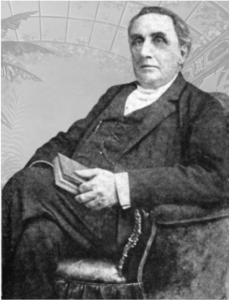
Ellwood H. Stokes.
Sattay continued to attend the Christian services at Ocean Grove, and when they were finished, he would stand outside the church. Many of the congregants, intrigued by Sattay’s Eastern clothing, approached him with questions regarding his beliefs and culture. Sattay answered their questions, and brief discussions on religion would develop. Whenever Stokes caught sight of this, he disbanded the crowd and ordered the women to return to their homes. When they would not obey, he would take Sattay by the arm and forcibly pull him away.
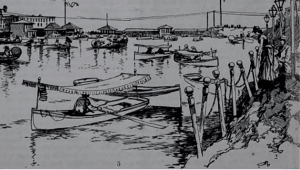
The Lake.
On August 18, 1886, the police forced Sattay into a boat, and sent him across the lake to the limits of Ocean Grove. Undeterred, Sattay returned the following day to attend the “camp-meeting like everybody else.” Upon his discovery, the police threatened to prosecute him for speaking to the people on the previous day on the grounds of “disturbance of peace and character.” Sattay ignored this threat and sat reading a newspaper on one of the benches near the Tabernacle. At 11 a.m. the police returned with a warrant, and took him into a police court near the association building. On the affidavits of two other officers, the chief of police, under order of Stokes, sentenced Sattay to thirty days in jail. He was immediately placed on the 4 o’clock train to Freehold, New Jersey, where the jail was located. The following day, August, 20, 1886, day Sattay wrote a letter to Gopalrao:
I am sorry to address you from a cell […] If you can see Dr. Stokes, I think you can procure pardon for me. Otherwise I must go through my thirty days. I have already passed two days. I am not at all disheartened. You need not be disturbed in your mind; but, if you are not going West with Dr. Joshee, I think you will do well to go to Asbury or Long Branch, and, if you can procure my pardon, we will never step into the limits of Ocean Grove any more. If even the streets and the beaches form a portion of their church limit, we have to conform to their rules. From my prison I will write letters to Dr. Stokes, Mrs. Inskip, and Mrs. Brooks, asking them to forgive my trespass, as God shall forgive theirs, as they ask in their daily prayer. I am sorry I did not take your advice of changing my residence. It is too late now. I have many sympathizers, but nobody knows I am in jail. It was done so suddenly and so secretly. Man must have all kinds of experience, and I am glad that I have this opportunity to learn how is the life of a prisoner. My conscience is not guilty. I have committed no criminal or civil offense. It is simply a persecution at the hand of an association that holds gospel in one hand and rod in the other. I am not ashamed to ask pardon, but I doubt whether Dr Stokes will grant it. There is no freedom in a Christian country. If we want to enjoy freedom, we have to be Christian, externally at least.
On August 24, 1886, The New York Tribune printed a short article about Sattay’s activities in Ocean Grove, stating that he “made himself obnoxious by making blasphemous utterances against Christianity. Sattay responded with a letter to the editor of the Tribune which said: “I shall feel very much obliged to you if you will kindly publish this, my letter, so that my sympathizers may know about it. I am penniless and friendless, and therefore I have no other help besides asking you to favor me. I beg to remain your obedient servant.”
Later that day the warden of the jail, C.A. Little, who was out of town, learned of Sattay’s confinement. Having attended some of Sattay’s talks in Ocean Grove, Little was sympathetic of his prisoner and “characterized his arrest as an outrage.” Little sought the advice of a local lawyer named E.W. Arrowsmith, who subsequently discovered that the papers in Sattay’s case had not been filed. The following day, August 25, 1886, Arrowsmith, who volunteered to plead on behalf of Sattay, put the case before Judge Joel Parker who immediately ordered Sattay’s release. Little then gave Sattay some money, and sent him on his way. On the day that Sattay was released, W.Q. Judge wrote a letter to “S. Covina Row Sattay Esq,” in which he stated:
Your letter to Bro. Joshi has been handed me, in which you request his aid in getting you out of jail. While I sympathize with you, and shall try to aid you in this matter, and can see that the Association acted contrary to their supposed religion, I cannot endorse the wisdom of your proceeding which caused you trouble. No one is more opposed to Christianity than I am, but I fail to see by what right you invaded the premises of these people and gathered listeners round you without leave. That is not freedom; it is license. No missionary in India would be allowed to enter a sacred temple and propagate his religion or run down the other. He would be arrested by the authorities. This camp where you were, is for them devoted to their absurd religion, and you had no right to go there except quietly. Had you held your meeting outside in the road, they could have done nothing. Therefore you do right in asking their pardon no matter how wrong they are. I hope they will let you out. Legally I do not see any other way for the offense was no doubt committed. I am also sorry to see that you write Joshee that there is no freedom here unless one pretends to Christianity. Such a course is wrong and very unnecessary. The Vedas say that you must not revile the gods of other men. Karma often follows quickly on such an act. I like you violently oppose Christianity which is really very weak here, but I would be mad to rush into their places of worship and preach contrary-wise. But you tried in the one place where they are strong. I should be sorry to see you pretend to Christianity. If you do you will be reviled by these people; if you do not, you will have the respect and aid of the hosts of non-Christian people who are all over this land. Joshee spoke against the religion in Boston and was well received but it was in a hall where free speech prevails. I will go down to Asbury Park today and try to see Stokes and do what I can for you. I do not know where your things are but will try and find them.
Judge then went to Freehold to inquire about Sattay. Finding that Sattay had already been released, Judge then went to The Sun to have a story sympathetic to Sattay published. It said in part:
[Sattay’s] impression of the land as formed at Ocean Grove, he said, had given him a different notion now. Sattay, however, displayed a forgiving spirit, but he thought the Methodists erred in going about with the Gospel in one hand and the rod in the other. As nearly as can be learned, the only charge made against the young Hindoo was that in the stronghold of midsummer Methodism he had attempted to demoralize the people by inveighing against the Christian missions in his native land. It is at least apparent that the missionaries have not converted him.
~
During the events at Ocean Grove, the Joshees were dealing with the worsening condition of Anandibai. It was decided that they should leave Niagara Falls for Philadelphia, where Anandabai could receive treatment at the Woman’s Hospital. Arriving on August 28, 1886, they remained in Philadelphia for a few days, before Ramabai accompanied her home to Roselle.
~
On August 31, 1886, Judge followed up with another letter to “S. Govina Row Sattay,” in which he states:
My name, which you could not read is, Wm. Q. Judge. I am pres’t of the N.Y. Theosophical Society and one of the founders of the Society whose headquarters now are in India, at Madras, and I was there in 1884. I saw The New York Sun about your case and they put in an account, and now a Herald reporter wants to see you about it. I did not mean that you had disturbed their services or blasphemed but that you had committed sufficient offense for them as they own the whole of Ocean Grove and can exclude anyone they like. I thought you were injudicious for I know the temper of these bigots. Next time you will not be caught. In any public place you can say what you please but not in a place like that. You have sympathizers everywhere. I went down to Ocean Grove and found you had got out and gone away and was sorry I missed you. So I did the next best thing which was to fully ventilate your case in the New York Sun and it has now gone over the whole country. I will show your letter to the Herald man and perhaps he may put in some more which will give those people at Ocean Grove a good public flogging which they deserve.
~
Assuming that Sattay’s letter from jail to Gopalrao was mailed on the same day it was written, on August 20, 1886. That would mean that the letter made it to upstate New York, was read by Gopalrao (who was en route to Niagara Falls,) and then made its way back to Judge in Manhattan in five days. It is not impossible, but it is improbable, especially for the postal service in 1886. Let us speculate on another possibility by first examining a statement issued by Gopalrao at this time:
So far from the Theosophists approving of Mr. Sattay’s preaching Hinduism within the grounds of a Methodist camp meeting, a Theosophist warned him against staying in Ocean Grove, as he would very likely be imprisoned by the missionaries; which he was.
It seems unlikely that Sattay was unaware of the New York Theosophists. The sentence in Judge’s letter, “My name, which you could not read is (italics mine,) Wm. Q. Judge…[President] of the [New York Theosophical Society,” gives one the impression that it was included to deliberately establish some plausible deniability as to their knowledge of one another. This is also the case with the mis-spelling of a Sattay’s name in both of his letters (e.g. “S. Covina Row Sattay” and “S. Govina Row Sattay,”) which is baffling since the newspapers accessible to Judge at the time were consistent with their spelling of Sattay’s name. Judge, likewise, would most certainly have been aware of Sattay, well before August, through his connection with Gopalrao. When we consider the reference to the mysterious stranger who visited Sattay in Ocean Grove, another picture begins to emerge.
Perhaps Judge, “a father from whom a daughter was snatched away in two days while she was in the flower of health,” orchestrated “a good public flogging,” of Stokes and the Methodists on the eighth anniversary of his daughter’s death, in the very place where she died. Perhaps the unnamed Theosophist who told Sattay that he would likely “be imprisoned by the missionaries,” at Ocean Grove did not do so as a warning, but rather, as part of a deliberate plan; a plan which showed “the people how wrong…their estimate [was] of the East, and what lies they [were] told by the missionaries,” while garnering sympathy for the people of India and making a martyr out of Sattay.
~
As one paper noted, Judge’s office was located conveniently near “the newspaper gang in Printing House Square,” and Judge, himself, worked for some time in The Tribune building on Nassau Street. As his letters to Sattay suggest, Judge had a special relationship with the New York reporters, and knew full well what a powerful tool the press could be in shaping public opinion, and he still had connections with David A. Curtis, a reporter, and early member of the Theosophical Society. Two weeks after Sattay was released from jail, the articles, “Theosophy In New York,” and “Buddhism In New York,” appeared in The World and The Sun, respectively. In both articles Curtis writes favorably of Sattay, Judge, and the Theosophical Society. Buddhism’s growing popularity in New York was “to an extent not dreamed of by the average Christian.” The article’s explained how the Aryan Theosophical Society was the public domain through which the mystical secrets of Buddhism may be learned, and listed works such as Sir Edwin Arnold’s the “Light of Asia,” the “Bhagarat-Gita [sic.]—the Bible of the Buddhist,” and the vegetarian “Buddhist Diet Book” as works to assist on the “difficult journey through matter to Nirvana. The last work, Laura C. Holloway’s Buddhist Diet-Book, was released that autumn; besides being one of the first vegetarian cook-books to be published in America, it pays a subtle nod to Blavatsky in the preface: “The exclusive [vegetarian] diet which my friends of Ladbroke Gardens [where Blavatsky lived,] Elgin Crescent, and Platz Hof Strasse offered their happy guest was a veritable physical regeneration.”
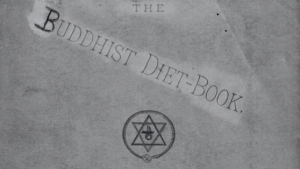
Buddhist Diet-Book.
PART IV.
The greater part of Anandibai’s final month in America was spent resting in bed or in the lounge. Gopalrao, Sattay, and Ramabai were by her side to make things as comfortable for her as possible. Early on the morning of October 9, 1886, the Joshees left Roselle for New York, where the Etruria would set sail for England at 8 a.m. A carriage was ordered thirty-minutes prior to the departure of their train, so that Anandibai could “see once more every home that had been open to her.” A party consisting of Sattay, the Carpenters, and Ramabai escorted the Joshees all the way to Pier 40, where the Etruria was docked. At some point in New York, Theodicia Carpenter asked Sattay to carry Anandibai’s valise, and through some mishap, the bag was dropped. The vials of perfume and cod liver oil contained inside “were smashed to pieces,” and Anandibai’s night-gown and woolen dresses were soiled. Once in England, the Joshees encountered a problem with the ticketing agency of Thomas Cook & Son. “I wish the English were whipped by every country as they were by America,” Gopalrao told readers of The Index, when narrating the events which transpired. Even though Gopalrao purchased tickets in New York for a steamer to India from England, he and Anandibai were denied passage “because of the avowed reluctance of the white passengers to travel with a Hindu in their company.” After a fruitless, and heated, exchange with the ticketing agent, Gopalrao returned to the hotel in which he and Anandibai were staying, to deliver the bad news. “During my absence from the hotel two or three English ladies called on Dr. Joshee,” writes Gopalrao, “and were informed of our going away next day.” While Gopalrao was seething over the “low character of the English,” Gopalrao states that “two other ladies,” paid them a visit to say goodbye to Anandibai. The “two other ladies,” Americans, of New England stock. The first was Carrie Borden, of Fall River Massachusetts, whom the Joshees met while lecturing in Boston. She arrived in England in September on the previous eastbound voyage of the Etruria. Borden was with Abigail Pattison (née Howe,) a Boston native who married an English geologist named Samuel Rowels Pattison. Gopalrao explained the situation to them, but they “could not believe it to be true.”
[Carrie and Abigail] took the matter in hand in right earnest. They canceled all their engagements for the day, and called on Cook & Son with an attorney. They found all we had said was true, and felt it was a shame to a Christian nation to have treated the heathen so mercilessly.
The next morning Gopalrao visited Samuel Pattison, who, after inquiring about “the probable deficiency” of their funds, gave Gopalrao a check for “eighty or ninety pounds.” With the generous gift from the Pattisons, Gopalrao was able to secure passage for Anandibai and himself on the P. & O. steamer, Peshawar. This last experience with the Pattisons rehabilitated, if only incrementally, Gopalrao’s estimation of the English: “[Mrs. Pattison’s] words at parting were more consoling and redeeming than all the dollars Dr. Joshee received as presents from her American friends in pomp. ‘I hope,’ said she, ‘you will not go home believing that there are no good people in England.’” Dall voices her suspicion of Gopalrao’s account in her autobiography of Anandibai, citing obvious errors in the chronology of his narrative. Ramabai was equally suspicious, writing: “At the time when I heard of it, I could not believe [it], and nobody could.” However, Ramabai, by chance, would confirm his story: “Miss Borden […] reassured me that the extraordinary treatment that Dr. Joshee and her husband received from the British India Steamship Company […] was quite true.”
PART V.
On November 13, 1886, just as the Joshees returned to India, the Bengali Theosophist, Mohini Chatterjee, another Brahmin, left London for New York on the Aurania. Arriving in New York harbor a week later, he was among the first to witness the illuminated Statue of Liberty, which “reminded him somewhat of the Hindu idols in his own country.” He left London in the midst of a romantic scandal that was checked in the press by William Wilde, “a man occupying an important journalistic position,” and the brother of Oscar Wilde. He was staying as the guest of Gebhard, co-editor of The Path, and though Mohini was a member of the Theosophical Society, his relationship with the movement was strained. At the docks he told reporters: “I am a member of the Theosophical Society, but I do not call myself a Theosophist, because that seems to imply the possession of absolute knowledge of the truth, whereas I am merely a seeker.” A few days later Mohini would elaborate on his views in an interview with a correspondent from The New York Tribune:
I am a member of the Theosophical Society, but I do not call myself a Theosophist, because that seems to imply the possession of absolute knowledge of the truth, whereas I am merely a seeker. To understand my position you must be acquainted with some of the beliefs I hold. It appears to me that the time is approaching when the East will be called upon once more to furnish a religious ideal to the West. You know that all former spiritual ideals have emanated from the Orient. Christianity came thence, and when Materialism and ecclesiastical corruption had so encrusted the living faith with superstition and ritualism as to obscure its beauty and destroy its elevating influence, it was again from the East that the revival of learning proceed which opened the partial return to a high ordeal […] The discontent which takes the form of Socialism is the natural result of a view of life which gives supreme importance to extremes.
Mohini’s disaffection with Blavatsky caused him to decline all public invitations by the Theosophists except for a few he promised to make for Judge. In keeping his word to Judge, Mohini spoke before the New York Branch soon after his arrival. Despite his drift from the movement, one of the first people he called upon was Laura C. Holloway, with whom he co-authored the book, Man: Fragments of Forgotten History in 1885.

Statue of Liberty & Mohini.
~
After Gopalrao and Anandibai departed, Sattay went to Elizabeth, New Jersey, where he learned the process of making photographic dry plates with a man named Schaffer. By the end of the year he was among the five hundred laborers employed at Charles Eisenmann’s photographic printing factory, located at 543 East Fifteenth Street in Manhattan. In December Sattay received news that the condition of Anandibai had worsened. The only thing he could do was ask the Carpenters to forward $100 from the money he had in deposit to Anandabai “to comfort her during the last weeks of her terrible illness.”
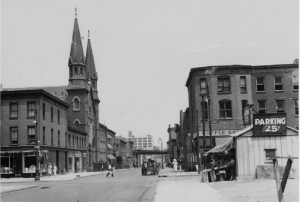
Duffield & Willoughby.
In February 1887, Sattay moved to 227 Duffield Street, Brooklyn. The former residence of the abolitionists, Harriet and Thomas Truesdell, Sattay’s new home, was rumored to have once been a stop on the Underground Railroad. Being just 500 feet from the residence of Judge on 116 Willoughby Street, we can assume that their close proximity afforded both men an opportunity for discussions on matters of shared spiritual interest. It is likely that Judge had a hand in securing Sattay’s room, as suggested in references to sponsoring a Sanskrit scholar in America in his letters to Blavatsky and Sumangala (e.g. “I guarantee to pay his passage here and back again to London, and to keep him while here,” and “I might be able to make arrangements in respect to the living here of such a person.”) Sattay continued working at Eisenmann’s factory, while also trying his hand at business by introducing Indian ceramics and perishable articles into the New York market. His whole business enterprise collapsed before it even began when the bulk of his invoice was destroyed by careless packaging. At the end of February Gopalrao received news that Anandibai passed away. It was said that “to no one was her early death a bitterer blow than to Sattay.”
~
On March 29, 1887, Mohini delivered a lecture, “Indian Theosophy: Its Relation To Western Civilization,” before The Nineteenth Century Club. Membership in the Society was slowly increasing, and the space in the Union Square Hall proved to be too small. In the early months of 1887, The Aryan Branch secured a room from the Constitution Club in Mott Memorial Hall, but as Mohini’s talk was expected to garner a larger audience, a room in the American Art Gallery at Madison Square South was rented. Mohini’s address attracted general attention with his eulogies of primitive Christianity. “He defined Theosophy as truth, and said that the great sale of Edwin Arnold’s Light of Asia showed how Indian ideas were influencing Europe.”
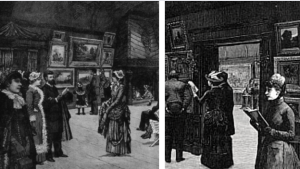
The American Art Galleries at 6 East Twenty-third Street.
The following day, March 30, 1887, Holloway hosted Mohini at her residence at 181 Schermerhorn Street, where he gave a more intimate talk on spirituality in general. It is likely that Sattay and Judge were among those present, especially since they lived a five minute (0.3 mi/0.48 km.) walk away.
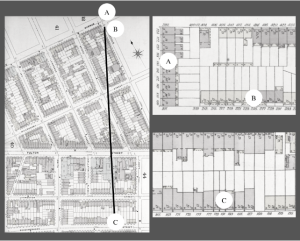
(Right.)1887 map showing: [A]116 Willoughby. [B] 227 Duffield Street. [C]181 Schermerhorn Street.
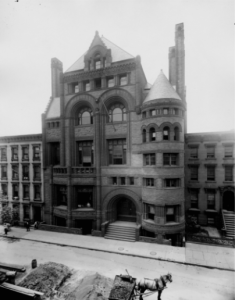
(Left.) Schermerhorn Street between Smith & Hoyt.
During these talks, Mohini discussed “how Indian ideas were influencing Europe,” and attracted general attention with his eulogies of primitive Christianity. Mohini made the claim that all spiritual ideas had their origin in the East. “Materialism and ecclesiastical corruption,” he stated, “encrusted the living faith,” of Christianity, and its beauty could only be restored from the East. “Christianity is at one with the Vedantic sacred canons in teaching that ‘the Kingdom of Heaven is within you,’” Mohini stated. The field for this “Theosophical Christianity” was first surveyed by his brother in the Brahmo Samaj, Protap Chunder Mazumdar, whose Oriental Christ was gaining traction in America.
~
Mohini’s Vedantic hermeneutics of Christianity, harmonious with the concept of reincarnation, would have a rippling effect. Among those present at the meeting was Edward Dwight Walker, now editor of Cosmopolitan Magazine. Walker would soon take up a study of what was known variously as “metempsychosis,” “transmigration of the soul,” or “reincarnation,” and deliver a series of lectures on the topic before the Aryan Branch meetings. These lectures were then published in The Path beginning in May, 1887. This was followed up with an additional serialized essay in The Path titled “The Poetry Of Reincarnation In Western Literature.” His efforts would culminate in the book, Reincarnation: A Study of Forgotten Truth (1888) the earliest textual occurrence linking Christianity with reincarnationist beliefs.
~
Following his stay in New York, Mohini lectured throughout New England, where his talks were received with great enthusiasm. Mohini’s open departure from the Theosophical Society was disheartening for Judge, but his hopes of spreading awareness of Eastern literature, and popularizing Sanskrit study in the West, were soon renewed with some unexpected news from Japan. Judge received a letter from the Japanese Buddhist scholar, Matsuyama Matsutaro, dated March 27, 1887. It read:
We beg your permission to take the liberty of writing this letter to you. We are the followers of Buddhism in Japan; and we learned lately from a Russian news that there are some Buddhistic followers in the United States. N. A., particularly in New York and Brooklyn, and that the application of the new converts are to be made to your Society; it is very strange to hear that there are some Buddhistic followers in your country, adding the new converts to their number. The Russian news goes as follows: ‘Buddhism has been lately introduced into New York and Brooklyn, and its followers are very rapidly increasing in number. It is said among them that they shall build a Buddhist temple in New York. Though Brooklyn now has no Buddhist body, yet there are many scholars in a school, superintended by the present president of your society.’ If this statement of the news be all right, we shall have a great pleasure of having Buddhism spread among the whites, such as the people of the United States, and are very desirous to hear some detailed statement about the things from you; and also, we cannot help being much interested in your efforts. But we cannot readily trust in these things, as told in the news. If you will give us kindly an epistle of, we shall have a great delight. So if we know that such as mentioned above are the real case, then we will gladly tell you about the present state of Buddhism, and other religions in Japan.
Judge replied:
I am a Buddhist but am not of a particular sect. I was made a Buddhist by Col. H.S. Olcott, in India, under the authority of the High Priest of Ceylon, and I try in every way to spread Buddhism…The account you read in the newspaper was in part true. There is no temple in this country. But there are many Buddhists. They do not properly understand it however, because there are no teachers, and many wicked lies are told against Buddhism by Missionaries and other people. The people need that religion because their own has not succeeded in making them honest or kind to each other. They are always fighting and going to law with each other although Jesus their prophet told them not to do so, but to love one another, and although they are not very happy, because the illusions of life make them slaves of the senses. So do tell your young men not to desert the law of Buddha for this religion but to try to spread Buddhism again over the face of the world.
Matsuyama wrote back to Judge:
I am very glad to receive your epistle, answering to us: I have taken a great pleasure to read in it, that the story we read in the Russian News, is in part true; and I am much interested of your earnest efforts of spreading the pure truth of Buddhism. In Japan, there are the twelve sects, or schools of Buddhism, and their principles are shortly explained in the small book, A Short History of the Twelve Japanese Buddhist Sects, which I presently send to you. All the people of this country are the Buddhist believers; but, unhappy to tell, many of them are merely nominal; and the doctrines of the Mahayana school are generally recognized and respected. There are a great may teachers and monks, with few nuns, of our religion, and the temples and monasteries in this land, are numerous and splendid; some of them being really huge and grand; the photographs, which you will find enclosed along with the book, show you some of them. I have a willingness to tell you and your associates about the principles of Buddhism, as recognized in this country, but as I at present find myself busy, I will write to you about that subject, after some days. Some missionaries from France, England, the United States, and Russia, are endeavoring to Christianize this country but for present their followers are few, and the influence of their religion is very weak upon our society. Our young Buddhistic men, particularly those of the Shin Shin sect, exhibit a strong spirit to propagate the truth of the great law over the face of the world, and they are making preparation in learning English and other languages. I have translated your letter, and inserted to some of our news, and I believe that it has made an interesting impression on our Buddhists. We are very desirous to make correspondence respecting to our religion with your associates and other people, so, I want you [to] kindly publish our wish. I am translating an essay, titled “A Brief Sketch of the General View of Buddhism in Japan,” and I suppose, this would be apt to make the foreign people know of the chief and central principles and dogmas of Buddhism in Japan. Sir, excuse me of the defective manner in writing. I am, indeed, a baby in English language.
~
Through Judge, Matsuyama received letters from other Theosophists, and from the Ceylonese Buddhist activist, Anagarika Dharmapala. Mohini left America in December 1887, and to returned to India. He severed his connection with the Society, and said he would never return to the West again. Judge, consequently, began to actively recruit domestic Sanskritists to join the Society. One such scholar was William E. Gates, “an intelligent young Southerner,” according to Judge, and a “student of Sanskrit,” who “graduated from John Hopkins University with high honors” in 1886. Gates joined the Society in November 1887, and would establish a Branch in Ohio in 1888.
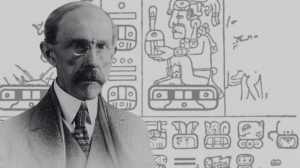
William E. Gates.
In later years Gates would form The Maya Society and publish a wealth of material related to ancient civilizations in America, a great deal of which being perfumed with Theosophical cosmology.
PART VI.
In 1888, Ramabai wrote her first English book, The High-Caste Hindu Woman, which she dedicated to Anandibai. The book was uncompromising in its condemnation of child brides and child widows, then a part of Indian culture.

Ramabai.
This work brought attention to Ramabai and her cause. She cultivated a network of leading reformers, and raised substantial funds to establish a school in India for child widows. On March 27, 1888, she was among the delegates to attend the International Council of Women in Washington, D.C. (along with Laura C. Holloway and Joslyn Gage.) Ramabai had the full support of Sattay, who wrote to Gopalrao in April, 1888:
Here, perhaps, you will ask me why we Hindus should take the trouble to educate the minds of Western nations in the literature, history, and religions of India. I ask you in return to look deep into the signs of the times. It seems as if the deliverance of India from foreign yoke is to be through the indirect influence of the American nation, and especially through the noble womanhood of America. Here I see the great use of Ramabai’s efforts. Whether our people appreciate them or not, the American institution will rise before September, 1889. Progressive Hindus will take advantage of it; and who can tell that one of the noble mothers will not bring forth a George Washington? I look for a manly generation in the future as one result of this noble aid.
Sattay was able to create a modest savings from Eisenmann’s by living off of bread and milk for a year. It was not without consequence. In April Sattay experienced a decline in health, and was bed-ridden for most of the month. Perhaps sensing his time was at hand, in the spring of 1888 Sattay proposed to build the “Dr. Joshi Cottage,” near the Carpenter’s residence in Roselle, the rooms of which would be “adapted to the use of Hindus whom he expected to arrive.” Sattay proposed to use all the money he had for the project, and made arrangements to borrow more. The Carpenters expressed their concern that Sattay was over-extending himself, but he replied: “I think patience and perseverance will enable me to carry out my scheme.” His health seemed to improve as summer drew near. It is possible that Sattay was responsible for the importation of Sanskrit texts, and other works of a spiritual nature, from the Bombay Theosophists. Early in the summer of 1888, Tukaram sent the entire consignment of his Yoga Philosophy of Patanjali to America.
Sattay then spent the summer in Saratoga, New York, where he continued giving talks on the British in India. The “morals and habits of the [Indian] people,” were corrupted under British rule, he stated, and the people of India now indulged in “excesses formerly unknown to them.” Sattay was among the attendees of the meeting of the American Social Science Association on September 3, 1888, where “the enthusiasm of his listening” was indicated by his “glowing eye.” Caroline Healey Dall, who had written a biography about Anandibai, was in attendance; and though she desired to meet Sattay, Dall feared that since her work was critical of Gopalrao, Sattay may not wish to associate with her. This would prove not to be the case. When Sattay returned to Brooklyn, he sent Dall a letter of praise in which he implores her to continue fighting for the cause of Indian women.
While in Saratoga last month I enjoyed the Social Science meetings and especially enjoyed your pointed remarks on almost every paper read then. Oh, how much I wished that I should make myself acquainted with you, but I knew that time was too valuable to you then, and the fatigue of your mental exercise was another cause that held me back from your presence. Soon after I left Saratoga and returned home to Brooklyn, I am therefore obliged to have recourse to writing. It might strike you strange to receive a letter from an unknown person. I have made America my home, and therefore I am more anxious for the welfare of my brothers and sisters in India. I therefore earnestly entreat you to devote yourself entirely to the cause of women in India. You will please try to keep that question alive for about ten years, as if Ramabai herself was here during the whole period. If you will do so, you will have the credit of saving a whole nation of 300,000,000 souls.
Dall states that it was “the first time that any male Hindoo of high caste has been known to express himself on the subject of the condition of women in his own country.” This claim is probably an exaggeration, but it is worthy of note as an early example.
Sattay was dying from (seemingly) tuberculosis, though know one knew it at the time, perhaps not even himself. Sattay was about to form a Sanskrit class among the students of Columbia College. On September 22, 1888, Govinda Row Sattay joined the Society as an unaffiliated F.T.S. Five days later, on September 27, he delivered a well-received lecture before the Aryan Branch titled “Jesus as a Theosophist.”
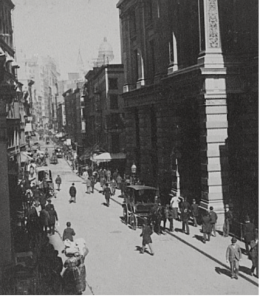
Nassau Street.
~
Earlier that summer, Judge secured Room 45 in his office building at 117 Nassau Street to serve as a Theosophical Headquarters. “Day after day he held meetings in his law office in Nassau Street, and sat there thinking and wishing for somebody to come in.” Judge devised a plan to draw people to the “Temple” by “[filling] it with idols and barbarian smells so as to strike awe to the visiting beholder.”
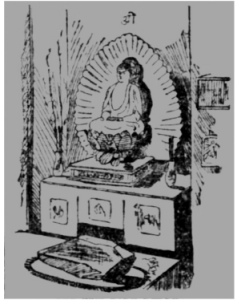
“The New York Buddha.”
The “Temple,” was located conveniently near “the newspaper gang in Printing House Square,” and the local papers were soon “busily engaged in working up the Theosophical Society of New York into a sensation.” It was said that “one day a newspaper reporter heard of this peculiar man [Judge,] who talked to a house full of empty chairs,” and decided to attend a meeting to report on the lecture. After that, Judge “never lacked an audience.” David A. Curtis mentioned in his article a visitor’s book which listed some names:
There is, moreover, a visitor’s book. In which I found alleged names in what is said to be Hebrew and Sanskrit. They were certainly not written in Italian script or Roman letters, but looked very much like a lot of parentheses and exclamation points. Other name were J. Ralston Skinner, of Cincinnati, Ohio; Prof. Piazzi Smyth, Sarah Fisher Ames, H. B. Foulke of Philadelphia, and many equally known to fame.
The article in The Brooklyn Times-Union described a “heathen priest” who attended the “Temple,” and provides the name “Balarama Naarayana Pelt.” This name is likely false. If there ever was an Indian man associated with the Temple, it was almost certainly Sattay. The references to “Balaram” have a tragic strata of meaning when considering Sattay’s illness: “He was rather taller than the average Hindoo, and immeasurably more emaciated than any other human being outside of a dime museum has a right to be.”
~
Around this time Sattay’s symptoms were becoming impossible to ignore. His friends encouraged him to go South with the hope that warmer weather would alleviate the symptoms. Sattay did not wish to remain idle, however, and planned on delivering lectures during the winter at any Branch of the Society that sponsored his travels.
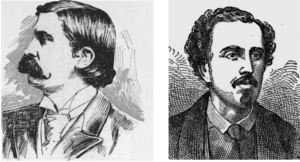
(Left.) Henry B. Foulke. (Right.) Horatio Eddy.
In the middle of October, Sattay paid an unexpected visit to Philadelphia, where he called on Henry B. Foulke, president of the Philadelphia Branch, who joined the Society on Christmas Eve, 1887. On the night that Sattay arrived, Foulke was hosting a séance conducted by Horatio Eddy. As reported in The Times-Picayune:
Eddy gave a séance and materialized three Hindoos whom Sattay had known in India and who died before he came to America. Sattay had always been skeptical regarding spiritualism, but the appearance of these old acquaintances in Indian robes and turbans converted him, especially as one of them solemnly warned hint in Hindoostanee that he was to die in a fortnight. Of course none of the American theosophists present understood what the spook said. When the séance was over Sattay declared that if his spirit was given the power he would reappear to his friends after he died. Then he returned to Brooklyn.
A renewed inquiry into Spiritualism occurred in October 1888. Maggie Fox-Kane, one of the three Fox Sisters whose “spirit-rappings” in Hydesville, New York, in the 1840s helped establish the modern Spiritualist movement recently confessed that the phenomena was fraudulently produced. On October 28 she would even give a demonstration at Brooklyn’s Grand Opera House during which she revealed how phenomena associated with Spiritualism were produced.
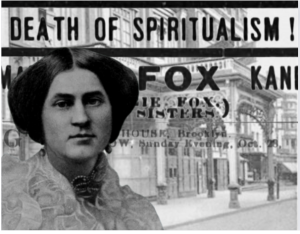
Maggie Fox-Kane & The Grand Opera House, Brooklyn.
~
Two weeks after the visit in Philadelphia, Sattay’s health rapidly declined. Judge arranged for him to be placed in a pay ward in the Brooklyn Hospital, “where the doctor in charge said he might linger some time but could not live.” Judge then sent word to the Carpenters explaining that Sattay was in the hospital and very ill. Sattay then explained to Judge that he was “ready to go away,” and that it was his wish to be cremated, and for his “ashes thrown upon the river, according to the custom of the country he loved too well.”
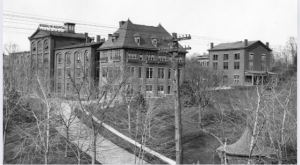
Brooklyn Hospital at Raymond Street and Dekalb.
Sattay then made a will on October 24, 1888, by which he left all of his savings, valuing two hundred dollars, to Judge in trust for the cause of Theosophy.
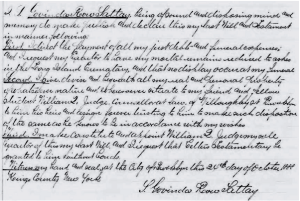
Sattay’s Will.
Theodocia Carpenter provides a full account:
[Sattay] had been there four days. We stood by his bedside till he woke. He rubbed his eyes as if he were not sure that he saw clearly, then gasped our names and asked for water. An attendant gave it to him; and he then looked up, and said faintly, “I am just in life, and that is all.” But he was bright and especially happy. His voice grew clearer. He said he was prepared for whatever might happen. He had made Mr. Judge his executor, and left nothing for us to do, because we were always so busy. This consideration was characteristic of the man […] He sent word to his friends that he was “happy and ready for whatever might come.” We had taken him some cooked Hindu dall and rice, and some fruit, his favorite diet. He said he was on a milk diet, and wanted only what the doctors allowed, but would we give these dainties to his friends; and he pointed to the other two men in the ward. I had taken him some reading matter. “Would I leave it for the others?” he asked; and then he added: “Where are the papers that should be in the hands of all these patients? I see boxes in all the railroad stations to receive them, but there are none here.” “I don’t know,” I answered with pain, remembering that I had never put any in. Now I thrust a roll into my husband’s hand every morning, as a tribute to dear Sattay’s memory. Although our friend talked steadily and with animation, yet, when Mr. Carpenter turned his back to set the basket of fruit on the table, he appeared to lose himself instantly in sleep. My husband spoke without noticing, and he roused. I was so afraid of exhausting him that I would not let him speak again. We withdrew, and he waved his hand, saying over and over again, “Good-by.” The few minutes that we dared to let him talk were too precious to ask questions in. We did not even ask what sickness he had been through since he wrote on the 15th. He pointed to the record on the wall, which indicated that he was alarmingly worse. I feared that he was dying. Had they told us so, I would have asked some questions for his friends’ sake. I could not tell whether it was death or a fearful crisis from which he might rally. We were left alone with him, and did not see the doctor. Sattay asked us to look round and see what a bright, cheerful room he was in. He said he had the best of care. His cot was near a window, through which the shifting clouds were seen, and where he was protected from draught by a white muslin screen. He was delighted to be where he made no trouble […] He passed away at the end of nine hours, without a struggle. The case was considered obscure, and an autopsy was held. It was decided that he had died of malarial fever.
~
Sattay died in Brooklyn Hospital on October 28, 1888. His last recorded words were: “If I die, all I have is for Humanity. If I live, I will always work for it.” When Judge arrived at the hospital following his death, he noticed that Sattay’s zānave was missing, and made an inquiry into their whereabouts. “After speculating upon its use, and telling silly stories about it, they burned it before I could get it,” Judge stated.
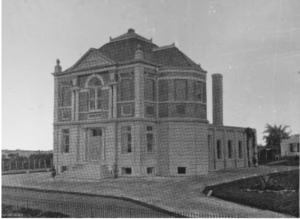
Fresh Pond Crematory.
~
In accordance with Sattay’s wishes, Judge performed a simple service in his honor at the Fresh Pond Crematory in Queen, New York. Sattay was the second Theosophist to be cremated in America, but the first Hindu of any caste, and the first South Asian. Judge, who was one of the officiants of the first cremation ceremony ten years earlier, likely used the same hymn provided by the Arya Samaj, which said in part:
The funeral fire is Kravyada. We walk that fire to the distance. May it reach the regions of the wind midway between heaven and earth. That fire is rapid in light. May it take thee quickly to the blessed regions. May other sacrificial fires and the grace of God ever shine in our midst, and bless the learned. Oh, being, do thou depart to the blessed regions. Do thou enjoy perpetual air, the firmament, the blessed body, the equally blessed knowledge and communion with God; and having enjoyed long life and the comforts thereof, do thou again thyself from the body and enter another blessed life. We pray to God, our common father and protector, that He may bless us perpetually. Oh being, may God, the preserver of us all, and the regulator of our lives according to our own ways of living, and the liberator from death or life, accept us, his suppliant creatures, and liberate us from all evils. Oh, God, who are free from all evils, do thou liberate this being and ourselves from evil.
~
Horatio Eddy gave another séance at Foulke’s house in early November, where the spirit of Sattay allegedly materialized. “The Hindoo was all there, even to the minutest details of dress,” the papers said. Foulke asked Sattay why he chose Philadelphia for his reappearance. Sattay’s spirit responded that “he wished to give testimony to the truth of theosophy in a country where it was not generally accepted,” the spirit then “indulged in some private communications, and vanished with the prediction that there would be a great spread of Buddhism in the near future.” Foulke who purchased some “Eastern curios,” from Sattay, would later claim that Sattay’s spirit inhabited a statuette of one such curio, a Tibetan Buddha. The story of Sattay and the séance soon filled the papers, and informed the next string of events.
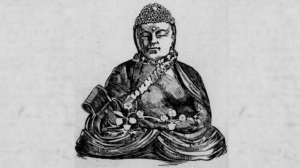
Foulke’s Buddha.
~
Judge left for Ireland on the H.M.S. Umbria on the morning of November 11, 1888. The purpose of the trip was to attend to the matters related to the death of his uncle, and assist Blavatsky with creating the rules for the new Esoteric Section of the Theosophical Society. The Umbria was involved in a collision with another ship, the Iberia, before reaching the open seas. The Umbria returned to port, and after undergoing the necessary repairs, resumed the voyage the following day.
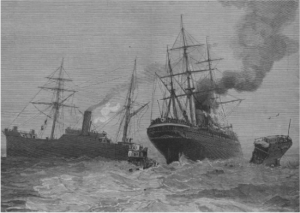
The collision between the Umbria and Iberia.
A rumor began to circulate, spurned by an article in The Sun, attributing the cause of the wreck to Judge carrying the ashes of Sattay on the Umbria. Soon the superstitious mariners and passengers claimed to see the “Shade of Sattay” on board the Umbria, and eyed Judge with suspicion. The Umbria reached her destination on the evening of November 19, 1888.
~
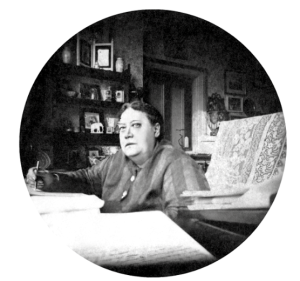
Photograph of Blavatsky by Judge in 1888.
When Judge arrived in London in 1888, political intrigue between Russian and Britain was exacerbated in the final days of the Anglo-Tibetan War. The British were fearful of Russia encroaching on India. In November 1888, the Russian General Pregavalsky died in Central Asia while attempting his fifth expedition to “break down the impenetrable barrier which [shut out] Tibet from the European traveler and the all-pervading civilization of the West.” A “curious rumor,” was circulating that General Pregavalsky’s death was simply misinformation spread by the Russians “to hide his operation from prying British eyes.” During Judge’s stay letters from British soldiers in the Tibetan campaign were reprinted in the British newspapers. One such letter stated that a soldier found a copy of the Theosophical work, The Occult World, in the library of Ladang Monastery, the residence of the Kubgen Lama of Sikkim. Evidently the monks, delighted by the stories of Blavatsky, had beautified the text with their own illustrations. This, however, was not the only talk regarding Tibetan excursions; Edmund Russell, one of Blavatsky’s inner circle, states that Nicolas Notovitch was present:
One encountered also that other strange Russian, with face like an icon, who wrote” The Unknown Christ,”claiming to have discovered in a Thibetan monastery records of those lost eighteen years of which no Evangel speaks. William T. Stead, W. Q. Judge, Mr. Sinnett, of course, were there.
Whether or not this Notovitch’s story was true, when Judge returned to New York, the story would be relayed to a member of the Aryan Branch named James H. Connelly, who would subsequently set to work translating the account from Russian to English.
While in London, Arthur Conan Doyle’s serialized story, “The Mystery of Cloomber,” appeared in The Pall Mall Budget. It was said that there was “little doubt that the influence of Blavatsky, Mr. A. P. Sinnett, and others of the occult school is making itself far more widely felt than many people imagine, and Dr. Doyle, presenting the most attractive side of the new, or rather the old philosophy…is doing more to arouse public interest than any purely technical book on the subject is capable of accomplishing.” Laura Holloway would make a similar statement in a column she wrote a column for the Times-Union (Brooklyn) in March 1889:
The most careless of observers must have noticed in the past four years the growing tendency in modern literature to discuss mysticism, occultism and theosophy. It has been very marked in fiction since the publication of Marion Crawford’s Mr. Isaacs. […] The majority of the writers on occult subjects are Hindus and English, and the best theosophical works issued in London. Among the many are Marie Corelli’s The Romance of Two Worlds, King Solomon’s Mines, and She.
Add to this list Sigmund Alexander’s The Veiled Beyond, for as one Boston paper stated:
The plot is based upon those theosophical theories which have recently found so much favor among us, and which owe their spread here largely, I suppose, to Mme. Helen Blavatsky and her coterie of disciples…Mr. Mohini Chatterji last year, when he visited Boston…created, as you probably remember, considerable stir in cultured circles. Very likely it was Mr. Mohinis visit that suggested the plot of The Veiled Beyond, and it is tolerably certain that but for the theosophical movement here of the last few years, the book would not have been written.
With the success that Theosophical ideas were having in the literary world, it would seem that Notovitch’s allegedly true account would make a rousing adventure-romance. In the meantime, Judge and Connelly would publish an “Americanized” version of Tukaram’s work on Patanjali titled, The Yoga Aphorisms of Patanjali. “Instead of being a translation,” Judge writes, “it is offered as an interpretation, as the thought of Patanjali clothed in [English.]”
At this time Matsuyama announced the creation of the Yamato Theosophical Society in Kyoto, Japan. In response, Judge sent a letter of support, which was published in Matsuyama’s journal, The Bijou of Asia: “The [American] people need the religion of Buddha because their own has not succeeded in making them honest or kind to each other […] they are not very happy because illusions of life make them slaves of senses.”
PART VII.
Judge remained committed to sponsoring an Asian Sanskrit scholar in America. He soon solicited the help from the Sri Lankan Buddhist scholar, Hikkaduwe Sri Sumangala Thero. In a letter from May 1889, Judge writes:
In consequence of the steady efforts made by the Theosophical Society during the last fourteen years, the people have had their attention directed to Theosophical doctrines and to Eastern religions and philosophies, and while it is true that a great number do not know what “Theosophy” means, the greater number of the people know something about Buddhism […] But if Buddhism is preached here solely by an American or European there will be a great disposition to criticize and perhaps laugh at him on the ground that he being a European or American cannot know what Buddhism is, since so many learned Europeans dispute as to its real meaning. I have therefore for some time thought that if a Buddhist priest, or more than one, were to come here and work with the people, churches could be founded and the doctrine disseminated very widely and rapidly; and I thought that perhaps you might be able better than anyone I know of to either find such willing persons or to designate them for the work. I cannot now however offer any livelihood or money to carry on such work, but if I had a favorable reply from you I might be able to make arrangements in respect to the living here of such a person. And if such a one were to be sent here, he would have to be a tried and proved man, because he would be subjugated to various temptations, such as flattery, adulation, attempts to draw him into a faction, or to convert him to some other method or belief. I speak from experience in respect to this for I have seen such things occur here with men who came from eastern lands […] I am satisfied that true Buddhism preached by a Buddhist priest properly authorized by you, would secure many believers.
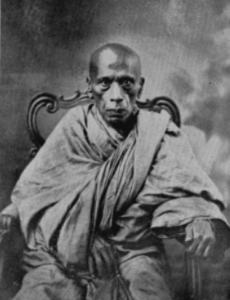
The Venerable Hikkaduwe Sri Sumangala Thero.
~
In the early part of 1890, Judge’s private office, “together with the Headquarters of the Society,” relocated to Room 25, at 132 Nassau Street. The bigger space had three rooms, “one devoted to The Path, one to the General Secretary, and the third exclusively to Headquarters.” With the new location, came a new approach to spreading the message of Theosophy. Rather than compete with Christianity, the hermeneutical approach of American Theosophists, especially those of the Aryan Branch, focused on the mystical nature of the Christos, and making the claim that the truth they possessed of the nature of Christ’s divinity predated the sacerdotal authority of the organized Christian church.
~
In January 1890, Judge began a series of articles for Kate Field’s newspaper, Washington, in which he expounds on Theosophical cosmology. In the first article Judge provides a definition for the semi-divine brotherhood of enlightened adepts who lived, occluded from the profane world, in the seclusion of the Himalayas. Judge writes:
The name applied to these beings is well known in the Sanskrit language: ‘Mahatma,’ a compound of two words, maha, great, and atma, soul […] The Mahatmas […] have preserved the knowledge of all natural laws for ages, not only by tradition among their disciples, but also by actual records and in libraries existing somewhere in the many underground temples and passages in India. Some believers assert that there are also stores of books and records in secluded parts all over that part of Thibet which is not known to Europeans, access to them being possible only for the Mahatmas and Adepts.
~
In 1890 Connelly published his translation of Nicolas Notovitch’s The Unknown Life Of Jesus Christ, and introduced to the anglophone world the idea that Jesus had undergone his spiritual training in India.
During my sojourn at Leh, capital of Ladak, I visited the great convent Himis, situated near the city, the chief lama of which informed me that their monastic library contained copies of the manuscripts in question. In order that I might not awaken the suspicions of the authorities concerning the object of my visit to the cloister, and to evade obstacles which might be opposed to me as a Russian, prosecuting further my journey in Thibet, I gave out upon my return to Leh that I would depart for India, and so left the capital of Ladak. An unfortunate fall, causing the breaking of a leg, furnished me with an absolutely unexpected pretext for returning to the monastery, where I received surgical attention. I took advantage of my short sojourn among the lamas to obtain the consent of their chief that they should bring to me, from their library, the manuscripts relating to Jesus Christ, and, assisted by my interpreter, who translated for me the Thibetan language, transferred carefully to my notebook what the lama read to me.
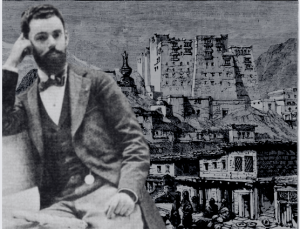
Notovitch & Leh.
~
In April, 1890, the Convention of the American Section of the T.S. was held in Chicago, Illinois. Bertram Keightley, Archibald Keightley’s uncle, was the visiting delegate. In his address to the Convention Judge praised India, while decrying the dangers of materialism he saw in the West. Judge then expressed his joy at the growth of Theosophy, and its receptivity in the public imagination. “Even with the limitations that now restrict us, we cannot but consider the growth of Theosophy in the past year as more than encouraging,—it is astonishing.” The positive sentiments of the Convention were soon replaced with troubling news. It was learned that while the Convention was underway, E.D. Walker had drowned under mysterious circumstances while traveling through the American South. While Theosophists were still mourning the loss of Walker, The Sun published an interview with a disgruntled Elliott Coues who made scathing indictments of Judge, Blavatsky, and the Keightleys. At a meeting of the Aryan Branch Society, at No. 8 Union Square on September 9, a resolution was passed to sue The Sun for libel. Judge then sent a letter to Blavatsky on September 12, 1890:
I want to lay before you again the matter of our having over here some Hindu upon whom we can rely to work for the T. S. with me. Can such a man be properly selected from among Hindu theosophists in London by you and the English F. T. S. without the necessity of my going to London for that purpose? The selection of a man ought to be with the needs of America in view and not from the English standpoint, either as to public speaking or otherwise. In America a man ought to be able to speak in public. It is a common habit and ability here. The coming over of a good man would do more to offset the recent scandals and take advantage of them than anything else we could imagine. And it must be a Hindu because a “foreign prophet is best.” Hence I do not want Mead or A[rch] K[eightley] or anyone English yet for this purpose specially. For qualifications: he must be able to speak publicly, must be devoted; must be somewhat acquainted with Sanskrit—the more the better; must understand and believe in Theosophy; must work with and under me and stray nowhere. It is necessary that the idea should be put in practise at once; hence my urgency […] I guarantee to pay his passage here and back again to London, and to keep him while here. This is all settled and certain, and I can make it good with cash by sending the money from here.
~
Just about the time Judge’s letter would have arrived in England, Archibald and Bertram Keightley (who left New York on June 18, 1890) met a young Mohandas Gandhi, who was then studying law in London. Gandhi states:
Towards the end of my second year in England I came across two Theosophist brothers, and both unmarried. They talked to me about the Gita. They were reading Sir Edwin Arnold’s translation—The Song Celestial—and they invited me to read the original with them. I felt ashamed, as I had read the divine poem neither in Samskrit nor in Gujarati. I was constrained to tell them that I had not read the Gita, but that I would gladly read it with them…They also took me on one occasion to the Blavatsky Lodge and introduced me to Madame Blavatsky and Mrs. Besant. The friends advised me to join the Society, but I politely declined…I recall having read, at the brothers’ instance, Madame Blavatsky’s Key to Theosophy. This book stimulated in me the desire to read books on Hinduism, and disabused me of the notion fostered by the missionaries that Hinduism was rife with superstition.
It is possible that the talk which the Keightley’s invited Gandhi to attend, was a lecture by Archibald Keightley himself, “Treatment of Animals,” which he delivered at the Blavatsky Lodge on September 18, 1890. The encounter between the Keightley’s and Gandhi, it would seem, was not a matter of chance, but rather an informal vetting interview to determine if the young Indian was a suitable scholar to recruit for Judge’s project.

Young Gandhi.
Though Gandhi would not join the Society, he was undeniably influenced by its ethos. Around the same time the Keightley encounter occurred, Charles T. Strauss would join the Aryan Branch; in 1893 he would be the first non-Asian to formally convert to Buddhism.
~
The last clear reference to the whereabouts of Sattay’s ashes are in 1892, when it was said they were in Judge’s custody, and would remain so “until the proper time comes to scatter them upon the waters to await the Great Pralaya.” The ashes may have been in Judge’s possession as late as 1896, just prior to his death. In a redacted letter from Judge to his protégé, E.T. Hargrove, published posthumously in The Theosophical Quarterly, we find the following statement:
There is a small room on the top story of 144 which has a Yale lock. In it are the following: [——] Now then: I want to give up the room to the Trustees. Take large sheets of wrapping paper and twine (Look out for ——’s curiosity.) […] Nobody knows what’s in the room, no matter what they may suspect; so don’t tell them.
⸻
SOURCES:
“Deaths.” The Dublin Evening Packet and Correspondent. (Dublin, Ireland) March 3, 1860.
“Novelties.” The Dublin Evening Packet and Correspondent. (Dublin, Ireland), April 29, 1861.
“Fleet Street Young Men’s Christian Union.” The Brooklyn Daily Eagle. (Brooklyn, New York.) December 3, 1866.
“Passengers Arrived.” Cosmopolitan. (London, England.) February 17, 1870.
“How Bones Are Utilized.” The Times-Picayune. (New Orleans, Louisiana) March 11, 1871.
“College Commencements.” The New York Herald. (New York, New York.) June 15, 1871.
“Fleet Street Young Men’s Union.” The Brooklyn Daily Eagle. (Brooklyn, New York), November 28, 1871.
“Board Of Education.” The Brooklyn Daily Eagle. (Brooklyn, New York.) November 12, 1873.
“Col. Olcott’s Lecture.” The Rutland Daily Globe. (Rutland, Vermont) December 7, 1874.
“Delafield Smith’s Defence.” The New York Daily Herald. (New York, New York.) March 1, 1875.
“Ocean Grove In 77.” The Monmouth Democrat. (Freehold, New Jersey) February 14, 1878.
“The Sea Side.” The New York Daily Herald. (New York, New York) March 14, 1878.
“The Winding Up.” The Ocean Grove Record. (Ocean Grove, New Jersey) August 31, 1878.
“Ocean Grove Camp Meeting.” The Philadelphia Inquirer. (Philadelphia, Pennsylvania) August 31, 1878.
“Ocean Grove.” The Leavenworth Weekly Times. (Leavenworth, Kansas) September 5, 1878.
Curtis, William E. “Baron De Palm’s Ashes.” The Sun. (New York, New York) October 20, 1878.
“Improvements.” The Times-Democrat. (New Orleans, Louisiana) October 23, 1882.
“A Hindoo Editor Sent To Gaol.” The South Wales Daily News. (Cardiff, Wales) May 7, 1883.
“Personal Items.” The Theosophist. Vol. IV, No. 45. (June 1883.)
“Mrs. Anandibai Joshee, Leader Of The Movement For Woman’s Emancipation In India.” Frank Leslie’s Sunday Magazine. Vol. XIV, No. 2. (August 1883.)
“The Great Meeting In The Town Hall.” The Englishman’s Overland Mail. (West Bengal, India) August 25, 1883.
“A Brahmin Lady Medical Student In America.” The Friend Of India and Statesman. (West Bengal, India.) August 25, 1883.
“Public Meeting Of The European And Anglo-Indian Communities.” The Friend Of India and Statesman. (West Bengal, India.) August 25, 1883.
“The Brahmo-Somaj.” The Boston Evening Transcript. (Boston, Massachusetts) September 17, 1883.
“Mozoomdar.” The Brooklyn Daily Eagle. (Brooklyn, New York) October 28, 1883.
“A Brahmin Lady In America.” The Times Of India. (Bombay, India) December 1, 1883.
“The Stage.” The Philadelphia Inquirer. (Philadelphia, Pennsylvania.) February 19, 1884.
“Maritime Intelligence.” The Shipping And Mercantile Gazette. (London, England) May 26, 1884.
“List Of Passengers.” The Homeward Mail From India, China And The East. (London, England.) June 23, 1884.
“Flogging Of The Coolies.” The Larne Reporter And Northern Counties Advertiser. (Larne, Northern Ireland) July 19, 1884.
“Theosophy And The Destiny Of India.” The Times Of India. (Maharashtra, India.) July 19, 1884.
“The Accident to The Valiant.” The Eastern Evening News. (Norfolk, England) July 22, 1884.
“Guion Line Of Steamers.” The Dublin Weekly News. (Dublin, Ireland) November 15, 1884.
“A New Sanskrit School.” The Madras Weekly Mail. (Tamil Nadu, India.) October 8, 1884.
“Lecture In the Temperance Hall.” The Overland China Mail. (Hong Kong, China.) November 25, 1884.
“Arrived.” The New York Times. (New York, New York) November 27, 1884.
“Cargoes.” The Overland China Mail. (Hong Kong, China.) January 20, 1885.
“City And Suburban News.” The New York Times. (New York, New York) February 18, 1885.
“Marine Intelligence.” The San Francisco Examiner. (San Francisco, California) March 9, 1885.
“Russia & Afghanistan.” The Essex Standard. (Essex, England) April 11, 1885.
“A Brahmin Advises His Compatriots To Come Here And Settle.” The Santa Cruz Sentinel. (Santa Cruz, California) May 6, 1885.
“A Brahman Explains His Religion.” The Rutland Daily Herald. (Rutland, Vermont.) May 8, 1885.
“Land Of The Brahmins.” The Evening Mail. (Stockton, California) May 21, 1885.
“The English In India.” The Weekly Times-Democrat. (New Orleans, Louisiana) May 23, 1885.
“Madison-Square Theatre.” The New York Times. (New York, New York) May 24, 1885.
“A Brahmin On Suicide.” The Detroit Free Press. (Detroit, Michigan) May 31, 1885.
“The Hindoo Hatred Of The English.” The Sacramento Bee. (Sacramento, California.) June 4, 1885.
“A Brahmin.” The Record-Union. (Sacramento, California.) June 5, 1885.
“Hindoo Metaphysics.” The Salt Lake Evening Democrat. (Salt Lake City, Utah) July 1, 1885.
“From A Hindoo.” The Richmond Dispatch. (Richmond, Virginia) July 12, 1885.
“News Of Friends.” The Friend’s Intelligencer. Vol. XLII, No. 11. (November 1885.)
“Hindoo Kindness To Animals.” The Knoxville Daily Chronicle. (Knoxville, Tennessee) November 8, 1885.
“The Occult World.” The Evening Star. (Washington, D.C.) November 14, 1885.
“A Night Of Fire.” The Times-Picayune. (New Orleans, Louisiana) January 13, 1886.
“An Epidemic Of Flame.” The Weekly Times-Democrat. (New Orleans, Louisiana) January 13, 1886.
“Brahmin Women Of Culture.” The New York Times. (New York, New York) March 3, 1886.
“The Rosine Home.” The Philadelphia Times. (Philadelphia, Pennsylvania) April 2, 1886.
“The Prophecy Of Nadigrandhams.” The Sun. (New York, New York) April 4, 1886.
“Walt Whitman.” The Republican. (Wellington, Kansas) April 24, 1886.
“The Path.” The Daily Republican. (Wilmington, Delaware) May 4, 1886
“Great Chicago Riot.” The Sun. (New York, New York) May 5, 1886.
“The Theosophists.” The Evening Star. (Washington, D.C.) May 8, 1886.
“Hot Conflagration.” The Times-Picayune. (New Orleans, Louisiana) May 17, 1886.
“What Free Thinkers Think.” The Democratic Age. (York, Pennsylvania) May 29, 1886.
“Report Of The Annual Meeting Of The Free Religious Association.” The Index. Vol VI., No. 50. (June 10, 1886.)
“Publication Of The Free Religious Association.” The Index. Vol VI., No. 50. (June 10, 1886.)
“Theosophical Activities.” The Path. Vol. I, No. 4 (July, 1886.)
“Searchers Of Mysteries.” The Democrat And Chronicle. (Rochester, New York) July 1, 1886.
“Independence Day Celebration.” The Ocean Grove Record. (Ocean Grove, New Jersey) July 10, 1886.
“Series Of Public Sessions.” The Democrat and Chronicle. (Rochester, New York) July 16, 1886.
“Open Theosophical Meeting.” The Democrat And Chronicle. (Rochester, New York) July 23, 1886.
“Town Talk.” The Democrat And Chronicle. (Rochester, New York) August 8, 1886.
“Mrs. Dr. Anandibai Joshee.” The Democrat and Chronicle. (Rochester, New York) August 11, 1886.
“The Heathen’s Argument.” The Democrat And Chronicle. (Rochester, New York) August 16, 1886.
“Very Unfavorable Comment.” The Democrat And Chronicle. (Rochester, New York) August 20, 1886.
“Advert: The Columbia.” The Ocean Grove Record. (Ocean Grove, New Jersey) August 21, 1886.
“Arrest Of A Blasphemous Hindoo.” The New York Tribune. (New York, New York), August 24, 1886.
“Ocean Grove’s Scandal.” The Sun. (New York, New York) August 29, 1886.
“The Hindoos.” The Democrat And Chronicle. (Rochester, New York), September 2, 1886.
“Patrick Ford Talking Back.” The Hartford Courant. (Hartford, Connecticut) September 07, 1886.
“Theosophy In New York.” The World. (New York, New York) September 12, 1886.
“Personal.” The Fall River Daily Evening News. (Fall River, Massachusetts) September 15, 1886.
“W.F.M.S.” The Ocean Grove Record. (Ocean Grove, New Jersey) September 18, 1886.
“Buddhism In New York.” The Sun. (New York, New York) September 26, 1886.
“Advert: Cunard Line.” The Brooklyn Daily Eagle. (Brooklyn, New York) October 8, 1886.
“A Hindoo’s Experience Of India.” The Times Of India. (Bombay, India) October 18, 1886.
“Liberty Unveiled.” The Sun. (New York, New York) October 29, 1886.
“Advert: Cunard Line Royal Mail Steamers.” The North British Daily Mail. (Lanarkshire, Scotland) November 10, 1886.
“A Hindu Philosopher.” The New York Times. (New York, New York) November 23, 1886.
“Liberty’s Torch Alight Again.” The Sun. (New York, New York) November 23, 1886.
“Oriental Theosophy.” The New York Tribune. (New York, New York) November 28, 1886.
“Announcement.” The Path. Vol. I, No. 9. (December 1886.)
“Bits About Prominent Ladies.” The Chicago Tribune. (Chicago, Illinois) December 16, 1886.
“Theosophical Activities.” The Path. Vol. I, No. 10. (January 1887.)
“The Talk Of New York.” The Brooklyn Daily Eagle. (Brooklyn, New York) January 30, 1887.
“‘Buddhism’ Boston’s New ‘Fad.’” The Buffalo Commercial. (Buffalo, New York) February 16, 1887.
“Hours Of Leisure.” The Sun. (New York, New York) March 28, 1887.
“Dipping Into Hindoo Lore.” The Sun. (New York, New York) March 30, 1887.
“He Was Weary When He Left.” The Brooklyn Daily Eagle. (Brooklyn, New York) March 31, 1887.
“Buddhism In New York.” The Sun. (New York, New York) May 22, 1887.
“Correspondence.” The Path. Vol. II, No. 7. (October 1887.)
“Interesting Gossip Of The Day.” The Sun. (New York, New York) December 19, 1887.
“Woman Suffrage.” The Fall River Daily Herald. (Fall River, Massachusetts) March 27, 1888.
“A Congress Of Women.” The Buffalo News. (Buffalo, New York) March 29, 1888.
“Letters To Theodore.” The Boston Evening Transcript. (Boston, Massachusetts) July 3, 1888.
“Theosophical Activities.” The Path. Vol. IV., No. 5. (August 1889.)
“People Talked About.” The Evening World. (New York, New York.) August 18, 1888.
“Theosophical Activities.” The Path. Vol. III., No. 7. (October 1888)
“Bombay.” Supplement To The Theosophist. (October 1888.)
“A Lady Spiritualist Confesses.” The St. James’s Gazette. (London, England) November 3, 1888.
“A Brooklyn Hindoo Burned.” The Lancaster Intelligencer. (Lancaster, Pennsylvania) November 7, 1888.
“Cut By A Cunarder.” The Daily Globe. (Saint Paul, Minnesota) November 12, 1888
“Steamers In Collision.” The New Haven Daily Mail Morning Journal And Courier. (New Haven Connecticut) November 12, 1888.
“Cut In Two At Sea.” The New York Tribune. (New York, New York) November 12, 1888.
“Gotham Gossip.” The Times-Picayune. (New Orleans, Louisiana) November 16, 1888.
“A Strange Ruse.” The Northern Scot and Moray & Nairn Express. (Grampian, Scotland) November 17, 1888.
“Gotham Gossip.” The Times-Picayune. (New Orleans, Louisiana) November 18, 1888.
“Mrs. Dall’s Work For The Women Of India.” The Buffalo Courier. (Buffalo, New York.) November 18, 1888.
“The Umbria’s Official Time.” The Brooklyn Daily Eagle. (Brooklyn, New York) November 20, 1888.
“Shade Of Sattay.” The Independent-Record. (Helena, Montana.) November 22, 1888.
“New York’s New Religion.” The Omaha Daily Bee. (Omaha, Nebraska) December 9, 1888.
“A Visit To Gangtok.’” The Englishman’s Overland Mail. (Calcutta, India) December 18, 1889.
“Ashes Not Scattered.” The New York Times. (New York, New York) December 31, 1888.
“The President-Founder’s Address.“ General Report Of The Thirteenth Convention Of The Theosophical Society. (1889.)
Nineteenth Century Club (New York.) Officers, Members, And Constitution: And A List Of The Lectures And Discussions Before The Club Since Its Formation. Printed by Albert B. King for the Nineteenth Century Club. New York, New York. (1889.)
“Obituary Notice.” The Supplement To The Theosophist. Vol. X., No. 4 (January 1889.)
“The Mystery of Cloomber.” The Portsmouth Evening News. (Hampshire, England) January 3, 1889.
“The Late Govinda Row Sattay.” Supplement To The Theosophist. (February 1889.)
“Theosophical Activities.” The Path. Vol. IV., No. 4. (July 1889.)
“Theosophical Activities.” The Path. Vol. IV., No. 5. (August 1889.)
“The Hammond Typewriter Company.” The American Stationer. Vol XXVI, No. 17. (October 24, 1889.)
“Theosophical Activities.” The Path. Vol. IV, No. 9. (December 1889.)
Report of The Theosophical Society, American Section. Fourth Annual Convention Held At Chicago, Illinois, April 27 and 28, 1890.
“Editor Walker Missing.” The Sun. (New York, New York) April 30, 1890.
“Obituary Notice.” The Path. Vol. V, No. 2. (May 1890.)
“A Magazine Editor’s Untimely Death.” The Bismarck Tribune. (Bismarck, North Dakota) May 23, 1890.
“Theosophical Activities.” The Path. Vol. V, No. 4. (July 1890.)
“In Her Memory.” The Ocean Grove Record. (Ocean Grove, New Jersey) August 23, 1890.
“To Press A Charge Of Libel.” The New York Tribune. (New York, New York) September 10, 1890.
“The Theosophists.” St. Louis Globe-Democrat. (St. Louis, Missouri) May 4, 1891.
“Lady Governors, Listen.” The World. (New York, New York) June 12, 1893.
“Gossip Of Authors And Writers.” Current Literature. Vol. XIV, No. 3. (November 1893.)
“Strange Rites.” The Cincinnati Post. (Cincinnati, Ohio) March 19, 1894.
“An Ex-Brahmin In Dublin.” The Dublin Evening Telegraph. (Dublin, Ireland) June 2, 1894.
“William Q. Judge.” The Brooklyn Daily Eagle. (Brooklyn, New York) July 28, 1894.
“Touched By Ghosts.” The Boston Globe. (Boston, Massachusetts) October 15, 1894.
“J.H. Campbell.” The Chicago Tribune. (Chicago, Illinois) April 13, 1895.
“W.Q. Judge’s Body Cremated.” The New York Times. (New York, New York) March 24, 1896.
“A President Of Shadows.” The Butte Daily Post. (Butte, Montana) April 25, 1896;
“The Pulse Of The People.” The Theosophical News. Vol. I , No. 6. (July 27, 1896.)
“Supernatural Power Attributed to An Idol.” The Philadelphia Inquirer. (Philadelphia, Pennsylvania) July 11, 1897.
“Joseph Smith.” The Brooklyn Daily Eagle. (Brooklyn, New York.) December 18, 1900.
“Joseph Smith.” The Times-Union. (Brooklyn, New York.) December 18, 1900.
“Social Prattle.” Town Talk. Vol. XVI, No. 831. (August 1, 1908.)
“Two Loyal Friends.” The Theosophical Quarterly. Vol. XIII, No. 3 (January, 1916.)
“Deaths.” The Salt Lake Telegram. (Salt Lake City, Utah) November 28, 1932.
A.E.S.S. “William Quan Judge.” The Canadian Theosophist. Vol. XX, No. 2 (April 15, 1939.)
Aiyar, B. V. Kamesvara. Sir A. Sashiah Sastri, K. C. S. I.: An Indian Statesman; A Biographical Sketch. Srinivasa, Varadachari & Co. Madras, India. (1902.)
Alexander, Sigmund Bowman. The Veiled Beyond: A Romance of the Adepts. Cassell & Company. New York, New York. (1888.)
Alexander, Thomas. Thom’s Almanac and Official Directory of the United Kingdom of Great Britain and Ireland for the Year. Vol. XXVI. (1859.)
Allen, J.A. Biographical Memoir of Elliott Coues 1842-1899. The National Academy of Sciences. Washington, D.C. (1909.)
Andreyev, Alexandre. Soviet Russia and Tibet: The Debacle of Secret Diplomacy, 1918-1930s. Brill. Leiden, Netherlands. (2021.)
Bacon, Edwin Monroe. Men Of Progress: One Thousand Biographical Sketches And Portraits Of Leaders In Business and Professional Life in The Commonwealth Of Massachusetts. New England Magazine. Boston, Massachusetts. (1896.)
Baker, Frances J. The Story of the Woman’s Foreign Missionary Society of the Methodist Episcopal Church, 1869-1895. Curts & Jennings. Cincinnati, Ohio. (1898.)
Bocking, Brian; Cox, Laurence; Yoshinaga, Shin’ichi. “The First Buddhist Mission to the West: Charles Pfoundes And The London Buddhist Mission Of 1889–1892.” Diskus: The Journal Of The British Association For The Study of Religions. Vol. XVI, No. 3 (2014.)
Bayly, Susan. The New Cambridge History Of India: Caste, Society And Politics In India From The Eighteenth Century To The Modern Age. Cambridge University Press. Cambridge, England. (1999.)
Beechey, Katherine A. “H.P. Blavatsky In London.” The Theosophist. Vol.LVIII, No. 10 (July, 1937.)
Blavatsky, H.P. “Recent Progress in Theosophy.” The North American Review. Vol. CLI, No. 405 (August 1890.)
Breitenbach, Esther. Empire and Scottish Society: The Impact of Foreign Missions at Home, c. 1790 to c. 1914. Edinburgh University Press. Edinburgh, Scotland. (2009.)
Bronkhurst, H.V.P. The Colony of British Guyana and Its Labouring Population. T. Woolmer. London, England. (1883.)
Buck, J. D. “His One Ambition.” Theosophy. Vol. XI., No. 2. (May 1896.)
Cannon, Jeffrey G. “The Image As Text And Context In Early Mormon History.” Essay in Foundational Texts of Mormonism. Mark Ashurst-McGee; Robin Jensen; Sharalyn D. Howcroft (eds.) Oxford University Press. Oxford, England. (2018.)
[Castle, Richard.] “Days With Mme. Blavatsky” The Hawaiian Gazette. (Honolulu, Hawaii) October 19, 1894.
Census Returns of England and Wales, 1891. Kew, Surrey, England: The National Archives of the UK (TNA): Public Record Office (PRO), 1891. Data imaged from The National Archives, London, England. 2. Birth date: abt 1810 Birth place: Strand, Gloucestershire, England Residence date: 1891 Residence place: Hampstead, London, England. Class: RG12; Piece: 107; Folio 14; Page 21; GSU roll: 6095217.
Chatterji, Mohini; Holloway-Langford, Laura. Man: Fragments of Forgotten History. Reeves and Turner. London, England. (1885.)
Chintamani, Chirravoori Yajneswara. Indian Social Reform: Being A Collection of Essays, Addresses, Speeches. Minerva Press. Madras, India. (1901.)
Cleather, Alice L. “In England And America.” Theosophy. Vol. 11, No. 3 (June 1896): 83-84.
Coleman, William Head. Historical Sketch Book and Guide to New Orleans and Environs. W. H. Coleman. New York, New York. (1885.)
Compton, Todd M.; Hatch, Charles M. (eds.) A Widow’s Tale: The 1884-1896 Diary Of Helen Mar Kimball Whitney. Utah State University Press. Logan, Utah. (2003.)
Connelly, J.H. “Our Friend And Guide.” Theosophy. Vol. XI, No. 3 (June 1896.)
Coues, Elliott. “The Occult World.” The Religio-Philosophical Journal. Vol. XXXIX., No. 26. (February 20, 1886): 2.
Coues, Elliott. “Blavatsky Unveiled” The Sun. New York, New York) July 20, 1890.
Curtis, David A. “Baron De Palm’s Ashes.” The Sun. (New York, New York) October 20, 1878.
Curtis, David A. “The Last Of Baron De Palm” The Sun. (New York, New York) November 21, 1878.
Curtis, David A. “A New Temple To Buddha.” The Times Union. (Brooklyn, New York.) December 1, 1888.
Cutler, Mary Charleen; Sharp, Glenda Irene Cutler. The Life Of William Willes From His Own Personal Journals And Writings. Family Footprints. Provo, Utah (1999.)
Dall, Caroline Healey. The Life Of Dr. Anandabai Joshee. Roberts Brothers. Boston, Massachusetts. (1888.)
Dall, Caroline Healey. “A Hindoo Theosophist.” The Unitarian Review. Vol. XXXI, No. 5. (May 1889.)
Daniels, Morris S. The Story Of Ocean Grove. The Methodist Book Concern. New York, New York. (1919.)
Devanesen, Chandran D.S. The Making Of The Mahatma. New Delhi, India (1969.)
De Steiger, Isabelle. Memorabilia: Reminiscences Of A Woman Artist And Writer. Rider & Co. London, England. (1927.)
England and Wales Death Registration Index 1837-2007. Bessie Olcott, 1870. Death: Axbridge, Somerset, England. General Register Office, Southport, England.
Gandhi, Mohandas. The Story Of My Experiments With Truth. Navajivan Press. Ahmedabad, India. (1927.)
Gardner, Juliet; Wenborn, Neil (eds.) The History Today Companion To British History. Collins & Brown. London, England. (1995.)
Godwin, Nathaniel & Olcott, Henry Steel. The Descendants Of Thomas Olcott: One Of The First Settlers Of Hartford, Connecticut. J. Munsell. Albany, New York. (1874.)
Goldberg, Ellen. “The Re-Orientation Of Buddhism In North America.” Method & Theory in the Study of Religion. Vol. XI, No. 4 (1999.)
H. “A Lecture At Bombay.” Supplement To The Theosophist. (September 1884.)
Hammer, Olav. Claiming Knowledge: Strategies of Epistemology from Theosophy to the New Age. Brill. Leiden, Netherlands. (2021.)
Hargrove, Ernest Temple. “Letters From W.Q. Judge.” The Theosophical Quarterly. Vol. XXXII, No. 3. (January 1935.)
Hirschmann, Edwin. “White Mutiny”: The Ilbert Bill Crisis in India and Genesis of the Indian National Congress. Heritage. Delhi, India. (1980.)
Holloway, Laura C. The Buddhist Diet-Book. Funk & Wagnalls. New York, New York. (1886.)
Holloway, Laura C. “Theosophy in Literature.” The Times Union. (Brooklyn, New York.) March 16, 1889.
Holloway-Langford, Laura. “William Quan Judge, A Reminiscence.” The Word. Vol. XXII, No. 2 (November, 1915): 75-89.
International Publishing Company. Illustrated New York: The Metropolis of Today. International Publishing Company. New York, New York. (1888.)
J.B.W. “In Memoriam.” The Cosmopolitan. Vol. IX, No. 3. (July 1890.)
Jenson, Andrew (ed.) Encyclopedic History of the Church of Jesus Christ of Latter-day Saints. Deseret News Publishing Co. Salt Lake City, Utah. (1941.)
Jewett, Sarah Orne. “Sarah Orne Jewett Letters of 1886: Celia Thaxter To Annie Adams Fields, June 1, Shoals.” The Sarah Orne Jewett Text Project.
Johnson, R. A. “‘Russians At The Gates of India’? Planning The Defence Of India, 1885-1900.” The Journal Of Military History. Vol. LXVII, No. 3 (2003.)
Johnston, Charles. “The Race Of The Brahmins.” The Madras Weekly Mail. (Madras, India) January 11, 1894.
Johnston, Charles. “East And West: Helping To Govern India.” The Atlantic Monthly. Vol. CIX, No. 3. (March 1912.)
Johnston, Charles. “A Vision Of Things To Come: Helping To Govern India.” The Atlantic Monthly. Vol. CXII, No. 6. (December 1913.)
Joshee, G.V. “Some Account Of Burmah.” The Mahratta. (Poona, India) July 13, 1884.
Joshee, G.V. “An Account Of Siam.” The Mahratta. (Poona, India) November 2, 1884.
Joshee, Gopal Vinayak. “Missionaries In India.” The Index. Vol VII., No. 4. (July 22, 1886.)
Joshee, Gopal Vinayak. “A Hindoo’s Opinion Of England.” The Index. Vol VII, No. 21. (November 18, 1886.)
Joshee, Gopal Vinayak. “An Indignant Letter From A Hindoo Brahmin.” The Index. Vol VII, No. 26. (December 23, 1886.)
Judge, William Q. “The So-Called Expose Of Madame Blavatsky.” The Index. Vol. VI No. 37 (March 11, 1886.)
Judge, W.Q. “Theosophical Activities.” The Path. Vol I., No. 1. (April 1886.)
Judge, William Q. “America: The Aryan Theosophist Of N.Y.” Supplement To The Theosophist. Vol VII. (April, 1886.)
Judge, W.Q. “A Prophecy About Theosophy.” The Path. Vol. I, No. 1 (April 1886.)
Judge, W.Q. “Another Theosophical Prophecy.” The Path. Vol. I, No. 2 (May, 1886.)
Judge, William Q. “Matters Touching Theosophy.” The Religio-Philosophical Journal. Vol. XL, No. 10. (May 1, 1886.)
Judge, W.Q. “Theosophical Activities.” The Path. Vol I., No. 4. (July, 1886.)
Judge, William Q. The Yoga Aphorisms of Patanjali. The Path. New York, New York. (1889.)
Judge, William Q. Echoes From The Orient. The Aryan Press. New York, New York.(1890.)
Judge, William Quan “Yours Till Death And After, H.P.B.” Lucifer. Vol. VIII, No. 46 (June 15, 1891.)
Judge, W.Q. “Faces Of Friends: Tookeram Tatya.” The Path. Vol. IX, No. 2 (May 1894.)
Judge, William Q. “Letters Of W. Q. Judge.” The Theosophist. Vol. LII, No. 4 (January, 1931.)
Judge, William Q. “Letters Of W. Q. Judge.” The Theosophist. Vol. LII, No. 5. (February, 1931.)
Judge, William Q. “Letters Of W. Q. Judge.” The Theosophist. Vol. LII, No. 8 (May 1931.)
Judge, William Q. “Letters Of W. Q. Judge.” The Theosophist. Vol. LII, No. 12. (September 1931.)
Judge, William Quan, and A. L. Conger. Practical Occultism. Theosophical University Press. Pasadena, California. (1951.)
Keer, Dhananjay. Mahatma Jotirao Phooley: Father Of Indian Social Revolution. Popular Prakashan. Bombay, India. (2002.)
Keightley, Archibald. “The Treatment of Animals.” Lucifer. Vol.VII No. 38. (London, October 1890.)
Keightley, Julia. “Tea Table Talk.” The Path. Vol. III, No. 9. (December 1888.)
Keightley, Julia. “William Q. Judge Pt I.” The Irish Theosophist. Vol. IV, No. 5. (February 15, 1896.)
Keightley, Julia. Letters That Have Helped Me. Vol. II. The United Lodge Of Theosophists. Los Angeles, California. (1920.)
Khandavalaval, Navroji D. “The Poona Theosophical Society.” Supplement To The Theosophist. (September 1884.)
Kosambi, Meera. “Multiple Contestations: Pandita Ramabai’s Educational and Missionary Activities in Late Nineteenth-century India and Abroad.” Women’s History Review. Vol. VII, No. 2. (1998.)
Kosambi, Meera. (Ramaswamy, Meera; Kolhatker, Madhavi; Mukherji, Aban, eds.) A Fragmented Feminism. Routledge. London, England. (2020.)
Lantz, Emily Emerson. “Maya Society Formed To Study Indian ‘Glyphs’ On Ancient Monuments.” The Sun. (Baltimore, Maryland.) June 13, 1920.
Leland, Kurt “Alarums and Excursions: William James And The Theosophical Society.” Theosophical History. Vol. XIX, No. 4 (October, 2018.)
Loomis, H. “Activity Of Buddhists In Japan.” The Independent. Vol XLI, No. 2121 (July 25, 1889.)
Lovell, John W. “Reminiscences Of Early Days Of The Theosophical Society Pt. VI.” The Canadian Theosophist. Vol. X, No. 6. (August 15, 1929.)
May, Caroline. The American Female Poets with Critical Notes. Lindsay & Blakiston. Philadelphia, Pennsylvania. (1848.)
M.W.H. “Renan’s View of Christianity.” The Sun. (New York, New York) November 25, 1883.
Manhattan, New York, New York, United States, reference in 3044 New York Municipal Archives, New York; FHL microfilm 1,324,357., Barber, Gertrude A., comp. Deaths taken from the “Brooklyn Eagle.” Volumes 1-27. n.p.: n.p., 1963-66.
McDonald, William; Searles, John E. The Life of Rev. John S. Inskip: President of the National Association for the Promotion of Holiness. McDonald & Gill. Boston, Massachusetts. (1885.)
Mitchell, Edward Page. Memoirs Of An Editor: Fifty Years Of American Journalism. Charles Scribner’s Sons. New York, New York (1924.)
Mitchell, Henry. “Dangers to be Avoided.” The Ocean Grove Record. (Ocean Grove, New Jersey) September 7, 1878.
Mozoomdar, P. C. The Oriental Christ. George H. Ellis. Boston, Massachusetts. (1883)
New York City Municipal Archives. Marriage, Brooklyn, Kings, New York, United States, New York City Municipal Archives, New York; FHL microfilm 1,543,913. New York City Marriage Records, 1829-1940. William Q. Judge and Ella Miller Smith, September 16, 1874.
“New York Passenger Lists, 1820-1891.” NARA microfilm publication M237 (Washington D.C.: National Archives and Records Administration, n.d.)
New York State Census, 1875. Brooklyn, Kings, New York, United States. P. 13. Line 37. State Library, Albany; FHL microfilm 1,930,217.
New York City Department of Records & Information Services; New York City, New York; New York City Birth Certificates; Borough: Brooklyn; Year: 1875.
New York, Kings County, Probate Records; Author: New York. Supreme Court (Kings County); Probate Place: Kings, New York.
New York City. “Harriet and Thomas Truesdell House.” New York City Landmarks Preservation Commission Brief. June 30, 2020.
Notovitch, Nicolas; J.H. Connelly (tr.) The Unknown Life Of Jesus Christ. R.F. Fenno Company. New York, New York. (1890.)
O’Hanlon, Rosalind. Caste, Conflict, And Ideology: Mahatma Jotirao Phule And Low-Caste Protest In Nineteenth-Century Western India. Cambridge University Press. Cambridge, England (1985.)
Olcott, Henry S. People From The Other World. American Publishing Company. Hartford, Connecticut. (1875.)
Olcott, Henry S. “A Most Astonishing Test.” The Sun. (New York, New York) August 27, 1875.
Olcott, Henry Steel. “The Immortal Life.” The New York Tribune. (New York, New York) August 30, 1875.
Olcott, Henry S. “The War’s Carnival of Fraud.” Essay in The Annals Of The War Written By Leading Participants North And South. The Times Publishing Company. Philadelphia, Pennsylvania. (1879.)
Olcott, H. S. “Old Diary Leaves: Chapter VIII.” The Theosophist. Vol. XIV, No. 3 (November 1892.)
Olcott, Henry Steel. “Tookaram Tatya.” The Theosophist. Vol. XIX, No. 10. (July 1898.)
Olcott, Henry Steel. Old Diary Leaves: Volume II. Theosophical Publishing Society. London, England. (1900.)
Olcott, Henry Steel. Old Diary Leaves: Volume III. Theosophical Publishing Society. London, England. (1904.)
Pandey, Gyanendra. A History Of Prejudice: Race, Caste, And Difference In India And The United States. Cambridge University Press. Cambridge, England. (2013.)
Parton, James. Sketches Of Men Of Progress. New York And Hartford Publishing Co. New York, New York. (1871.)
Pennington, Brian K. Was Hinduism Invented? Oxford University Press. Oxford, England. (2005.)
Sarasvati, Ramabai. The High-Caste Hindu Woman. J. B. Rodgers Print. Company. Philadelphia, Pennsylvania. (1888.)
Rogers, Katherine M. L. Frank Baum: Creator of Oz: A Biography. St. Martin’s Publishing Group. New York, New York. (2002.)
Russell, Edmund. “As I Knew Her.” The Herald Of The Star. Vol. V, No. 5. (May 11, 1916.)
Russell, Edmund. “The Secret Doctrine: Personal Recollections Of Madame Blavatsky.” The Occult Review. Vol. XXXI, No. 6. (June 1920.)
Sarasvati, Ramabai; Kosambi, Meera (ed.) Pandita Ramabai’s American Encounter: The Peoples of the United States (1889.) Indiana University Press. Bloomington, Indiana. (2003.)
Sasson, Diane. Yearning for the New Age, Laura Holloway-Langford and Late Victorian Spirituality. Indiana University Press. Bloomington, Indiana. (2012.)
S. Govinda Row. “To The Editor Of The Times Of India S. Govinda Row, Of Sholapore.” The Times Of India. (Maharashtra, India.) August 31, 1883.
Sattay, Govindarao. [Bengal Cor. New Orleans Times-Democrat] “A Curious Hindoo Prejudice.” The Marion Star. (Marion, Ohio) November 16, 1885.
Sattay, S. Govinda Row. “The Imprisoned Hindoo.” The New York Tribune. (New York, New York), August 27, 1886.
Shah, A.B. (ed.) The Letters and Correspondence of Pandita Ramabai. The Maharashtra State Board For Literature And Culture. (1977.)
Shufeldt, R.W. “The Occult World.” The Religio-Philosophical Journal. Vol. XXXIX., No. 23. (January 30, 1886.)
Siddall, J. W. Men Of Hawaii: Vol. II. Honolulu Star-Bulletin. Honolulu, Hawaii. (1921.)
Sinnett, Alfred Percy. Incidents In The Life Of Madame Blavatsky. G. Redway. London, England. (1886.)
Stiles, Henry Reed. The Civil, Political, Professional And Ecclesiastical History, And Commercial And Industrial Record Of The County Of Kings And The City Of Brooklyn, N. Y. From 1683 To 1884: Volume I. W.W. Munsell & Co. Brooklyn, New York. (1884.)
Tatya. Tookaram. The Yoga Philosophy, Being The Text Of Patanjali, With Bhoja Raja’s Commentary. [Second Edition: Revised, Edited and Reprinted for the Bombay Theosophical Publication Fund.] Printed at the Subodha-Prakash Press. Bombay, India. (1885.)
Tatya, Tookaram. A Guide To Theosophy. Joint-Stock Printing Press. Bombay, India. (1887.)
Tatya, Tookaram. A Compendium Of The Raja Yoga Philosophy. Bombay Theosophical Publication Fund. Bombay, India. (1888.)
Taylor, William. Ten Years Of Self-Supporting Missions In India. Phillips & Hunt. New York, New York. (1882.)
Temple, Richard Carnac. Journals Kept in Hyderabad, Kashmir, Sikkim, and Nepal. W.H. Allen & Company. London, England. (1887.)
Thackeray, E.A. “Mrs. Laura Holloway Langford.” The Writer. Vol. V, No., 6. (June 1891.)
Thaxter, Celia. “Celia Thaxter Letter Extolling The Virtues Of Theosophical Literature And The Search For Truth [February 9, 1886.]” The Dobkin Family Collection of Feminism. Item ID#: 4653771a.
Theosophical Society General Membership Register, 1875-1942 at http://tsmembers.org/. See book 1, entry 109. (website file: 1A: 1875-1885) David A. Curtis. (10/5/76.)
Theosophical Society General Membership Register, 1875-1942 at http://tsmembers.org/. See book 1, entry 207. (website file: 1A: 1875-1885) Gopal Vinayak Joshee. (8/19/79.)
Theosophical Society General Membership Register, 1875-1942 at http://tsmembers.org/. See book 1, entry 292. (website file: 1A: 1875-1885) Tookaram Tatya. (5/1/80)
Theosophical Society General Membership Register, 1875-1942 at http://tsmembers.org/. See book 1, entry 1307. (website file: 1A: 1875-1885) Jotirao Govindrao Phooley. (08/14/82.)
Theosophical Society General Membership Register, 1875-1942 at http://tsmembers.org/. See book 1, entry 1721. (website file: 1A: 1875-1885) Anandibai Joshee. (3/11/83.)
Theosophical Society General Membership Register, 1875-1942 at http://tsmembers.org/. See book 1, entry 2923. (website file: 1B:1885-1890) Elliot Coues. (6/7/84.)
Theosophical Society General Membership Register, 1875-1942 at http://tsmembers.org/. See book 1, entry 3274. (website file: 1B:1885-1890); Matilda Joslyn Gage. [12/17/1885.]
Theosophical Society General Membership Register, 1875-1942 at http://tsmembers.org/. See book 1, entry 3507. (website file: 1B:1885-1890); George D. Ayers. [12/17/1885.]
Theosophical Society General Membership Register, 1875-1942 at http://tsmembers.org/. See book 1, entry 3569. (website file: 1B:1885-1890) Ida Botha.
Theosophical Society General Membership Register, 1875-1942 at http://tsmembers.org/. See book 1, entry 3570. (website file: 1B:1885-1890) Celia Thaxter.
Theosophical Society General Membership Register, 1875-1942 at http://tsmembers.org/. See book 1, entry 3646. (website file: 1B:1885-1890) J. Campbell VerPlanck. (05/27/1886.)
Theosophical Society General Membership Register, 1875-1942 at http://tsmembers.org/. See book 1, entry 3586. (website file: 1B:1885-1890) Edward D. Walker. (2/21/86)
Theosophical Society General Membership Register, 1875-1942 at http://tsmembers.org/. See book 1, entry 4240. (website file: 1B:1885-1890) William E. Gates. (11/20/1887.)
Theosophical Society General Membership Register, 1875-1942 at http://tsmembers.org/. See book 1, entry 4034. (website file: 1B:1885-1890) Henry B. Foulke. (12/24/87)
Theosophical Society General Membership Register, 1875-1942 at http://tsmembers.org/. See book 1, entry 4577. (website file: 1B:1885-1890) S. Govinda Row Sattay. (9/22/88.)
Theosophical Society General Membership Register, 1875-1942 at http://tsmembers.org/. See book 1, entry 4755. (website file: 1B:1885-1890) James Henderson Connolly. (1/14/89.)
Theosophical Society General Membership Register, 1875-1942 at http://tsmembers.org/. See book 1, entry 6201. (website file: 1C:1890-1894) Charles T. Strauss. (9/30/90.)
Theosophical Society General Membership Register, 1875-1942 at http://tsmembers.org/. See book 1, entry 8509. (website file: 1C:1890-1894) Lyman F. Baum. (9/2/92.)
Vinton, Francis. Celebration Of The Opening Of The Packer Collegiate Institute For The Education Of Females In The City Of Brooklyn. Van Anden’s Steam Presses. Brooklyn, New York. (1854.)
Walker, E.D. “Reincarnation: A Western Study Of The Subject.” The Path. Vol. II, No. 2. (May 1887.)
Walker, E.D. “The Poetry Of Reincarnation In Western Literature Pt. I.” The Path. Vol. II, No. 4. (July 1887.)
Walker, E.D. “The Poetry Of Reincarnation In Western Literature Pt. II.” The Path. Vol. II, No. 5. (August 1887.)
Walker, Edward Dwight. Reincarnation: A Study of Forgotten Truth. John W. Lovell Company. New York, New York. (1888).
Walker, Edwin D. “The New Religion.” The Arena. Vol. VII, No. 2 (January 1893.)
Whitman, Walt. “Walt Whitman Papers in the Charles E. Feinberg Collection: Diaries, Diary Notes, and Address Books, 1863-1891.” Diaries; 1876-1891, commonplace books; Vol. 1. March 2, 1876-May 30,1889. Image 167. November 24, 1885 entry.
Willes, William. “Gopal Vinayak Joshee.” The Salt Lake Herald. (Salt Lake City, Utah.) June 28, 1885.
Wills And Indexes, 1787-1923; Author: New York. Surrogate’s Court (Kings County); Probate Place: Kings, New York.
Woodward, Horace Bolingbroke. The History of the Geological Society of London. Longmans, Green, And Co. London, England. (1908.)
Yoshinaga, Shin’ichi. “Theosophy and Buddhist Reformers in the Middle of the Meiji Period.” Japanese Religions. Vol. XXXIV, No. 2 (2009.)
Ancestry.com. Philadelphia, Pennsylvania, U.S., Death Certificates Index, 1803-1915. [database on-line]. Provo, UT, USA: Ancestry.com Operations, Inc., 2011; Norbury, Mackenzie George; Rhoades, Nelson Osgood (eds.) Colonial Families of the United States of America. Vol. I. Genealogical Publishing Co., Inc. Baltimore. Maryland. (1995): 549.
[Year: 1864; Arrival: New York, New York, USA; Microfilm Serial: M237, 1820-1897; Line: 1; List Number: 661.]


